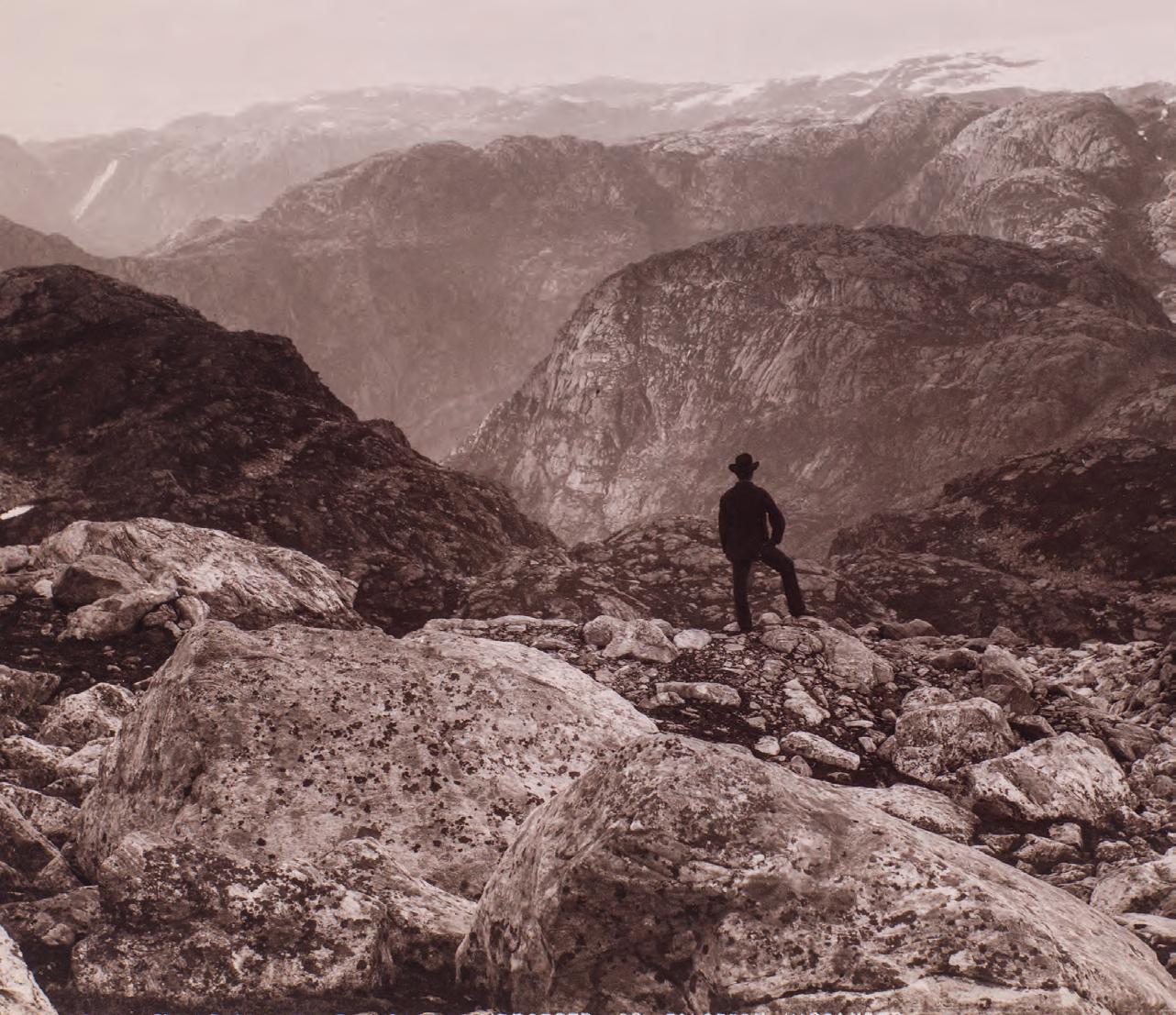













Free Museum admission, early access to event tickets, discounted program prices, savings in the Museum Store, and more.
nordicmuseum.org/membership
The Magazine of the National Nordic Museum
EDITORIAL BOARD AND MAGAZINE STAFF
Eric Nelson Executive Director/CEO
Leslie Anne Anderson Director of Collections, Exhibitions, and Programs
Jenny Iverson Development Manager
Erik Pihl Director of Development
Rosemary Jones Publisher/Director of Marketing
anay Nowlin Art Direction/Graphic Designer
CONTRIBUTORS
Leslie Anne Anderson | Alison DeRiemer Shannon Egan Marthe Tolnes Fjellestad
Carly Hinman Jenny Iverson Rosemary Jones | Terje Leiren Erik Pihl | Gregory Scuggs
BOARD OF TRUSTEES
Trustees
Hans Aarhus (President) Jay L. Bruns, III (Vice President) Earl Ecklund (Treasurer) Monica Langfeldt (Secretary)
Thomas Malone (Immediate Past President) Electa Johnson Anderson Lars Anderson Anne-Lise Berger
Jann Blackbourn Ray Brandstrom Ulf Edwaldsson Ann-Charlotte Gavel Adams Mike Hlastala Jane Klausen
Terje Leiren Kurt Manchester Jens Molback Kurt Ness Krystn Nesselquist | Per Norén Aaron Overland
Tuula Rytilä Maria Jones Staaf Johan Erik Strand | Henrik Strabo Heli Suokko | Lisa Toftemark
Honorary Consuls
Mark T. Schleck, Honorary Consul, Denmark Matti Suokko, Honorary Consul, Finland Kristiina Hiukka, Honorary Vice Consul, Finland
Geir Jonsson, Honorary Consul, Iceland
Viggo Forde, Honorary Consul, Norway
Petra Hilleberg, Honorary Consul, Sweden
Honorary Trustees
Senator Reuven Carlyle Leif Eie Irma Goertzen Senator Mary Margaret Haugen
Lars Jonsson Council Member Jeanne Kohl-Welles Senator Marko Liias
Fidelma McGinn | Representative Gael Tarleton | Margaret Wright
Executive Eric Nelson Executive Director/CEO
Sandra Nestorovic Chief of Staff
Jacob Andsager Head of Digital Strategy
Development
Erik Pihl Director of Development
Jenny Iverson Development Manager
Rachel Ballister Membership and Database Coordinator
William Ekstrom Development Events Coordinator
Marketing & Communications
Rosemary Jones Director of Marketing
Carly Hinman Marketing Specialist
anay Nowlin Graphic Designer Finance & Human Resources
Pamela Brooks Director of Finance and Human Resources
Carolyn Carlstrom Bookkeeper
Michael Ide Human Resources Coordinator
Timothy Krumland Volunteer Coordinator Curatorial

Leslie Anne Anderson Director of Collections, Exhibitions, and Programs
Stina Cowan Educational and Cultural Programs Manager
Alison DeRiemer Archivist and Oral History Specialist
Kate Dugdale Education and Interpretation Specialist
Pete Fleming Exhibition Designer and Preparator
Kaia Wahmanholm Registrar and Collections Specialist Operations
Adam Lee Allan-Spencer Director of Operations and Facilities
Donna Antonucci Guest Services and Event Associate
Roberta Chen Store and Guest Services and Store Associate
Allie Cheroutes Venue Services Coordinator
Rachael Ecklund Guest Services and Store Associate
Tanya Fitch Guest Services and Store Associate
Abigail Fredrickson Store and Guest Services Associate
Becky Forsberg Guest Services Manager
Joni Hughes Museum Store Retail and Purchasing Manager
David Leers Facilities Supervisor
Dana Lo Guest Services and Store Associate
Neil Tiland Custodian/Facilities Assistant

Welcome to Nordic Kultur, the magazine of the National Nordic Museum!
In the following pages you will find some fascinating stories that examine a host of compelling topics, including articles about this year’s upcoming exhibitions, events and happenings at the National Nordic Museum. We are particularly excited by From Dawn to Dusk: Nordic Art from Sweden’s Nationalmuseum; an exhibition featuring fifty-six works by leading Swedish, Norwegian and Danish artists of the late nineteenth and early twentieth centuries. The exhibit, on display through July 17, includes masterpieces from acclaimed artists Anders Zorn, Carl Larsson, Vilhelm Hammershøi, August Strindberg, Bruno Liljefors, Nils Kreuger, and Hanna Hirsch-Pauli, amongst others. Our Museum is the exclusive US venue—and this is an experience not to be missed.
Read more about our upcoming exhibitions including Across the West and Toward the North: Norwegian and American Landscape Photography which gives us an intriguing look at the changes that took place in the American West and northern Norway during the latter half of the nineteenth century, and the Mygration exhibition featuring the work of Sámi artist Tomas Colbengtson and Swedish artist Stina Folkebrant. The latter exhibit and article explore issues of migration, herd mentality, time, and the forgotten past.
The Museum’s 2022 Nordic Innovation Summit, which will occur on May 19, features prominently in this issue. This year’s theme “Innovating for Our Common Future” addresses multilateralism and interdependence of nations in the search for a sustainable development path. Topics will include the issues around safety in food processing, the future workplace, sustainable urban development, carbon sequestration, water technology, and biotech. This important conference will be held in person at the Museum, but virtual content will be made available on our website following the program.
I have only mentioned a few of the fantastic articles within this issue. We hope you will find Nordic Kultur a compelling touch point with the National Nordic Museum and inspire you to visit us here in Seattle.
Eric Nelson Executive Director/CEOFrom Dawn to Dusk: Nordic Art from Sweden’s Nationalmuseum

February 19, 2022–July 17, 2022


The National Nordic Museum presents fifty-six paintings by Danish, Norwegian, and Swedish artists held in the collection of the Nationalmuseum in Stockholm, Sweden. The exhibition traces the final decades of the nineteenth century, a period of radical development in art of the Nordic countries, through scenes of everyday life, portraits, and landscapes by Vilhelm Hammershøi, Hanna Hirsch-Pauli, Carl Larsson, August Strindberg, Anders Zorn, and many others. THIS EXHIBITION IS SUPPORTED BY ANN-CHARLOTTE GAVEL ADAMS, PETER AND SOPHIA KU IN HONOR OF MRS. VIOLA EVELYN GREATHOUSE, MARIA STAAF AND WILLIAM JONES, BARBRO OSHER PRO SUECIA FOUNDATION, THE ROBERT LEHMAN FOUNDATION, AND THE SCAN DESIGN FOUNDATION.
Across the West and Toward the North: Norwegian and American Landscape Photography
August 6, 2022–November 27, 2022
This exhibition presents a new examination of Norwegian and American landscape photography in the nineteenth and early twentieth centuries. At the present time of devastating climate change and political conflicts about the environment and energy consumption, this exhibition considers a historical moment when once remote wildernesses were first surveyed, developed, and photographed on both sides of the Atlantic Ocean. Drawing from the University of Bergen’s Picture Collection in Bergen, Norway; the Norsk Folkemuseum in Oslo, Norway; and a private collection, the exhibition investigates how two countries responded to the tourism influx, infrastructure changes, exploitation of natural resources, and the resulting effects of mapping and exploration. THIS EXHIBITION IS SUPPORTED BY THE NYSETHER FAMILY FOUNDATION.
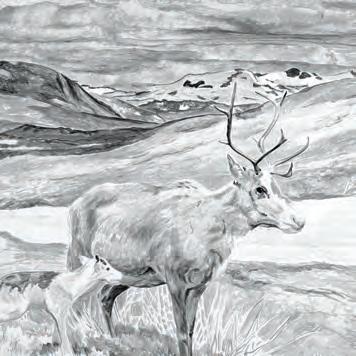
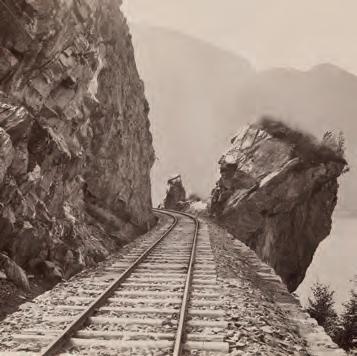
December 9, 2022–March 5, 2023
The work of Sámi artist Tomas Colbengtson and Swedish artist Stina Folkebrant explore issues of migration, herd mentality, time, and forgotten past. In preparation for Mygration, Colbengtson selected and printed archival photos of Sámi immigrants to Alaska in the 1890s, which are paired with Folkebrant’s large-scale paintings of the eight seasons of the mountain world, illustrating the Sámi concept of time and the life of the reindeer. The paintings are hung in a circle with the photographs at center, inviting the visitor to become immersed in a panoramic image. THIS EXHIBITION IS SUPPORTED BY KRUEGER
AND
SHEET METAL PACIFIC S Á MI SEARVI. COVER IMAGEIn 2022, the National Nordic Museum opens its biggest exhibition to date. From Dawn to Dusk: Nordic Art from Sweden’s Nationalmuseum is a survey of Scandinavian painting from the late nineteenth and early twentieth centuries, a period when artists of this region revolutionized the art establishments of Copenhagen, Oslo, and Stockholm. The artists synthesized contemporary ideas, practices, and styles that they encountered in Paris to depict the motifs of their home region. The exhibition features canonical works by artists such as Vilhelm Hammershøi, Hanna Hirsch-Pauli, Carl Larsson, L. A. Ring, Frits Thaulow, and Anders Zorn, held in the celebrated collection of Sweden’s Nationalmuseum. I spoke with curator Carl-Johan Olsson of the Nationalmuseum about the themes addressed in the exhibition and the works on display.

LAA: Leslie Anne Anderson, Director of Collections, Exhibitions, and Programs, National Nordic Museum
CJO: Carl-Johan Olsson, Curator of 19th-Century Painting, Nationalmuseum
LAA: What new ideas and styles did the Nordic artists encounter in Paris?
CJO: Paris in the late nineteenth century must have been quite overwhelming for anyone arriving there from the North. To take Swedish artists as an example, they came from a rather conservative academic climate in Stockholm. The Royal Academy of Fine Arts focused almost entirely on narrative history painting. This, together with an old-fashioned education and limited opportunities to exhibit one’s work, led to a growing dissatisfaction among the younger generations. Paris was like entering a whole new world. In comparison to Stockholm, the Parisian art world was an endless field of different paths and prosperous opportunities. France was the land of opportunity and, at the time, Paris was the incontestable art capital of the world. Here, it was possible to study at private academies with greater freedom than at home. This applied not least to the women artists as their training at the Academy in Stockholm was restricted in several aspects.
Nordic Artists were fascinated with Impressionism, but most considered it too radical in a painterly sense. For them, the less controversial naturalism was a logical leap from the history painting back home, allowing them to use what they had learned in technical terms, but choosing more modern subjects.

LAA: One of the themes of the exhibition is artistic camaraderie. Tell us how relationships between Nordic visual artists, writers, and musicians of this period informed the work of each.
CJO: The aspects of camaraderie and relations between artists have become a flourishing scholarly field over the last decade. As artists away from home, it was extremely important to be part of networks for several reasons. These included financial reasons, as well as support and encouragement. As most of the artists were quite poor, they helped each other in different ways. For example, they posed as models for each other’s paintings. Visual artists certainly hung out with writers and musicians, but it is difficult to find examples of specific outcomes in terms of collaborations. I think it was manifested rather in terms of inspiration.
LAA: Several artists featured in the exhibition belonged to artists’ colonies such as Grez-sur-Loing in France and Varberg in Sweden. How did these communities enrich or shape the participating artists’ works?
CJO: I dare say the colonies were crucial. Particularly the one in Grez, where artists could work in a kind of isolation, distant enough from Paris to dissolve the impressions of the metropolis and to create in peace. One such example is Carl Larsson, who had spent several years in Paris searching for an own way of expressing himself painterly. It was not until he arrived in Grez that he got his act together and painted watercolors that were praised at the annual Salon and immediately sold to the most important collector of the time, Pontus Fürstenberg.
Varberg, in its turn, was different. In the late 1880s, concerns were raised that Nordic talent was wasted on French subjects. In Sweden, this coincided with an economic downturn that tempted many people to leave the country for better opportunities in America. Art was considered a possible way to promote the qualities of the native country and to stimulate the people’s love for it. The most ambitious effort to formulate a national visual art was made by Richard Bergh, Nils Kreuger and Karl Nordström. At an early stage they realized that they needed to leave Stockholm in order to find an untouched part of Sweden and they
PREVIOUS SPREAD
Elisabeth Keyser (Swedish, 1851–1898), Self-Portrait, 1880
FACING PAGE
Carl Larsson (Swedish, 1853–1919), The Author August Strindberg, 1899.

THIS PAGE: UPPER IMAGE
Nils Kreuger (Swedish, 1858–1930), Spring in Halland, 1894. Three Paintings in a Frame Sculpted by the Artist.

THIS PAGE: LOWER IMAGE
Otto Hesselbom (Swedish, 1848–1913), Summer Night Study, undated.
FOLLOWING PAGES:
John Sten (Swedish, 1879–1922), Autumn Landscape, 1906.
Anders Zorn (Swedish, 1860–1920), Dalecarlian Girl Knitting, Kål-Margit 1901.
Olof
settled in Varberg on the southern west coast of Sweden. Here, they interpreted the landscape in a way similar to Gauguin’s way of portraying Brittany (in the northwest of France) and their images from the early 1890s mark the start of a new era of Swedish art. The three artists were more of a unit than the artists had been in Grez.
LAA: Artists collected each other’s paintings, drawings, and prints. Richard Bergh owned Landscape from Brittany (1889) by Paul Gauguin, which inspired the creation of John Sten’s Autumn Landscape (1906). Swedish artist Anna
Boberg owned Otto Hesselbom’s Summer Night. Study and Carl Larsson’s Ulf. Nude Boy Among Birches. What does an artist’s private collection tell us about their work and milieu?
CJO: This is a very interesting subject. Some artists hardly owned any works by colleagues, while others were extensive collectors. I think that often it was about economy. Artists like the Bobergs were quite well off and could pretty much acquire what they wished to own. In the case of Richard Bergh, it was the same, as his father was a highly
successful landscape painter. I like to believe that in both these cases the works were chosen out of pure passion, as a source of inspiration. This is particularly true in the case of Bergh acquiring Gauguin, as he generously made it available to fellow artists. Then, there are artists like Zorn, who built historic collections of a kind that seems to serve the purpose to strengthen a certain image. No doubt Zorn was a passionate art lover, but the composition of his collection is suspiciously similar to old aristocratic collections. He liked to consider himself a kind of princely painter, which is why collecting probably was about more than gaining inspiration for him.
LAA: French artist Paul Gauguin was a powerful influence on Nordic artists. Why did his adoption of Synthetism— the use of pronounced outlines and flat areas of color to achieve a more symbolic representation of nature—resonate with some of the artists included in the exhibition?
CJO: I think the artistic development in the North was consistent with the development in France in the later part of the late nineteenth century. Younger artists felt a desire to create something new, something on their own instead of repeating what had been the painterly idiom for almost twenty years by then. Furthermore, Synthetism and its colors must have been ideal for portraying the change of season, which is a lot starker in the North than, for example, in France. Look at Helmer Osslund, who mastered this better than most. Another important factor, particularly in Denmark, was that Paul Gauguin in fact lived there for some time, as he married a Danish woman, Mette Gauguin. Hence, his influence is stronger and clearer in Denmark than in Sweden.

LAA: Why is landscape a frequently depicted subject matter among the Nordic artists who were interested in the Symbolist movement?
CJO: I think it partly has an explanation in the fact that Nordic nature is quite different from the nature on the continent [of Europe], thus offering an opportunity to achieve a more geographically-specific or rather nationally-specific expression. The light can also be said to serve symbolistic purposes; after all Symbolism is quite closely related to the Nordic saga tradition making the core of these works similar.
LAA: There are several canonical works on the exhibition checklist. Why did works like Olof Arborelius’s Lake View at Engelberg, Västmanland (1893) and Anders Zorn’s Dalecarlian Girl Knitting, Kål-Margit (1901) gain popularity? What lesser-known works do you think merit additional attention?

CJO: I think it has to do with a combination of the ability to embody something that reflects many people’s concept of what is “Swedish,” but also with the fact that these paintings have been actively communicated as such in several different contexts. A hundred years ago, when we were not inundated with images, it was a lot easier for museums and similar institutions to control visual communication through reproductions and literature. To try to launch an image in a similar way today, you must use different channels and the competition is a million times tougher. In the exhibition, there are several works by lesser-known artists that I consider masterpieces. Look for example at the small fjord view by Sophie Werenskiold—it has been in the museum’s collection since the early twentieth century, but nearly a hundred years ago it was sent off as a long-term loan and did not reappear until just a few years ago. It is a rare work by an artist who, like many women at the time, gave up painting as she got married. The portrayal of the humid atmosphere of the scenery is unbelievably sensitive, yet sharp.
LAA: Growing a collection through gift and purchase allows curators to expand narratives, telling previously untold stories. What are some recent acquisitions of nineteenth-century Nordic painting that will allow the Nationalmuseum to better represent the art of this region and period?
CJO: Over the last years, we have been working hard to make acquisitions to be able to reflect art history more accurately at the museum. A priority has been works by women artists and there are several such examples included in the exhibition. One of my favorites is Esther Almqvist’s Weeping Birch Tree, that we acquired less than a year ago and that makes its exhibition debut in Seattle. It is a key work in itself, but also through its extraordinarily rich exhibition history, making it a kind of cornerstone in the international reception of Swedish art. Another recent acquisition is the very colorful landscape by John Sten, a work that stands out in the artist’s production and in
Swedish art. There are few examples of this kind of pure Synthetism, and Sten himself made only a very small number before he turned into a Swedish kind of Cubist. I really hope you will enjoy them!

The National Nordic Museum presents fifty-six paintings by Danish, Norwegian, and Swedish artists held in the collection of the Nationalmuseum in Stockholm, Sweden. The exhibition traces the final decades of the nineteenth century, a period of radical development in art of the Nordic countries, through scenes of everyday life, portraits, and landscapes by Vilhelm Hammershøi, Hanna Hirsch-Pauli, Carl Larsson, August Strindberg, Anders Zorn, and many others. This exhibition is supported by Ann-Charlotte Gavel Adams, Peter and Sophia Ku in honor of Mrs. Viola Evelyn Greathouse, Maria Staaf and William Jones, Barbro Osher Pro Suecia Foundation, The Robert Lehman Foundation, and The Scan Design Foundation.

For more information on the Swedish Nationalmuseum, visit nationalmuseum.se/en
Leslie Anne Anderson is Director of Collections, Exhibitions, and Programs at the National Nordic Museum. A former Fulbright grantee to Denmark and American-Scandinavian Foundation Fellow, Leslie specializes in nineteenth-century Nordic art. Her curatorial work has received the Award for Excellence from the international Association of Art Museum Curators. She has published articles in numerous scholarly journals, and she serves on the editorial board for the peer-reviewed journal arts. Born to a Cuban mother and a Danish-American father, her current curatorial interests lie in contemporary cross-cultural artistic conversations.
come President of South Seattle Community College and later the first Chinese-American Chancellor of the Seattle Community College District, overseeing three colleges.
whose act of generosity and kindness changed the trajectory of Peter’s life. Through their support of the exhibition, the Kus want to recognize Mrs. Greathouse and to amplify the kindness they have experienced from Nordic people and Nordic-Americans.

Peter Ku, originally from China, came to Seattle in 1990 to become President of North Seattle Community College. He was the first Chinese, or even Asian, immigrant to be appointed president of any college in the State of Washington. He went on to be-

Born in Mei County, Guangdong Province, in 1938, Ku was living in Taipei and teaching English in a high school in Changhua in the early 1960s. He dreamed of coming to the United States to pursue his education, and was aware that a high school classmate was studying at the University of Washington. At the time, if you were a foreign national and wanted to study in the United States without a scholarship, “you had to something for you.” Just prior to returning to the United States, she gave Ku a check for $2,100 to cover his costs. Ku was in shock and he told her, “I have nothing to guarantee the money will be paid back.” She said, “Don’t worry about it, I know you are honest. I think you are going to have a good future in the US.”
Ku decided to attend the University of Minnesota and began graduate school in the fall of 1963. He earned a Master’s Degree in Library Science in 1966. While studying for his Master’s, he worked four different
part-time jobs to pay tuition and living expenses, as well as to repay his benefactor. He got his first job at East Carolina University library without applying. While there, he obtained a second Master’s Degree, in Education Administration. Later, he went on to receive a PhD in Education Administration with an emphasis on community colleges at Duke University.
Ku was selected to be President of North Seattle Community College in 1990 from a pool of 138 candidates and moved his family to Seattle later that year. Throughout the years, Ku maintained close contact with Greathouse. She visited Peter and his family when they lived in Maryland. She was thrilled when he decided to come to Seattle in 1990.
Ku devoted his entire professional career to the community college system because he strongly believed in its mission of educating and helping people, particularly new immigrants, the underprivileged, and the disadvantaged to improve their lives. He has always been a strong advocate for quality teaching and student learning through faculty development. Ku brought additional resources to the colleges by expanding international trade and international education programs and securing federal grants. He was recognized for creating a harmonious and trustworthy environment throughout the entire college community. Upon his retirement, the Board of Trustees of the Community Colleges honored him by establishing the Peter C. Ku Scholarship Endowment Fund at the North Seattle Community College Foundation and named the education building at North Seattle the Peter C. Ku Building.
Mrs. Evelyn Greathouse’s 1963 investment in the promising career of a young man in Taiwan had a multiplier effect: it not only changed his life but has also had a significant impact on the many students of Seattle Colleges both during and following his tenure. An impact that ultimately extends to our entire region.
Thank you to Peter and Sophia Ku for honoring Mrs. Greathouse through your generous support of the Museum and for sharing the story of her wonderful gesture of kindness.
Among mankind’s oldest symbols, labyrinths date from the Neolithic age and have been passed down through the classical and medieval worlds to the present day. From their earliest pre-historic appearance on the Iberian Peninsula, labyrinths spread north along the Atlantic coast to the British Isles and east into the Mediterranean ancient worlds of Greece and Rome. A labyrinth’s spiral pattern is understood to have evolved from ring markings as far back as 7000 BCE.
In Greek mythology, the labyrinth was a complicated maze built at Knossos by Daedalus for King Minos of Crete to contain the Minotaur, a mythical creature with a human body and the head and tail of a bull. Navigating through the terrifying labyrinth, the hero Theseus kills the Minotaur and goes on to establish Athens as the dominant city in the eastern Mediterranean.
The Theseus-and-Minotaur myth was well known in Rome and the popularity of the labyrinth symbol spread throughout the Roman Empire: they were popular as decorative floor mosaics, often depicting Theseus killing the Minotaur. Following the declaration of the Edict of Milan by Emperor Constantine in 313 CE recognizing Christianity as an accepted religion in the Empire, Christian churches were often decorated with square labyrinths. The earliest known such decoration was the St. Raparata Labyrinth in the former North African Roman territory of Algeria. Rather than being the symbol of fear and trepidation that labyrinths were in pagan ritual, the Church found new meaning: labyrinths now became symbols of hope and a representation of the believer’s journey through a world of temptation and evil. With a cross at the point of entry, the now circular labyrinths symbolized Christ’s victory over death.
by Terje Leiren, PhDTroy (Trojaborg). The Trojaborg labyrinths spread around the Baltic coasts of Sweden and Finland and into the arctic region of Sápmi, including Finnmark in Norway and the Kola Peninsula, between the twelfth and eighteenth centuries.
Nordic folk traditions suggest several functions for, and meanings behind, the use of labyrinths. The winding journey to the center and back, common in the pilgrimage ritual, also suggests the labyrinth’s utility in an initiation process. The initiate enters a complex path where choices must be made on the way to the center and back. A symbolic death and rebirth ritual is sometimes emphasized by the physical orientation of the labyrinth, where one enters the labyrinth facing west toward the setting, or “dying”, sun. The subsequent exit from the labyrinth comes facing the “reborn” sun in the east. Games with subtle sexual associations, such as the so-called “Virgin Dances” in Finland or the “Virgin Circle” in Sweden, have traditionally been played out in labyrinths. The ritual presents a girl or young woman standing in the center of the labyrinth while young men walk or run through the maze to free her from the “fortress.”
Early twentieth-century accounts from coastal Sweden tell of fishermen walking the labyrinth prior to going fishing in the Baltic. Because trolls could upset the prospect of success, the fishermen carried out a ritual whereby they slowly walked the maze with the trolls following. Upon reaching the center, the fishermen ran the maze in reverse and jumped into their boats, leaving the slower trolls unable to follow them and, likewise, unable to spoil their fishing success.
An aesthetically pleasing symbol, the meanings and uses behind the labyrinth can be practical or fanciful, personal or collective, religious or secular.
Throughout the Middle Ages, labyrinths grew in religious significance, often representing a vicarious pilgrimage for those otherwise unable to take lengthy pilgrimage journeys to Rome or Jerusalem. Absorbed into Christian ritual early, the use of labyrinths moved north with the expansion of the Roman Church. In the migration, they carried with them the names of eastern Mediterranean fortress cities, such as Jericho, Jerusalem, Babylon, Constantinople, and, especially,
Multi-functional throughout history, its complex simplicity mirrors the human mind that imagined it and found use and meaning in it.
Recommended Reading:
Herman Kern, Through the Labyrinth (New York, 2000)
Di Williams, Labyrinth: Landscape of the Soul (Glasgow, 2011)
Craig Wright, The Maze and the Warrior: Symbols in Architecture, Theology, and Music (Cambridge, 2001)
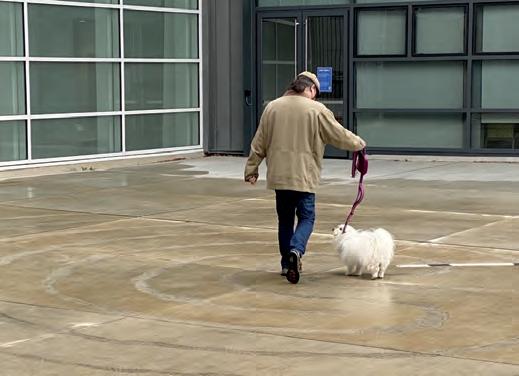
The National Nordic Museum’s newest permanent feature is a 32-foot by 35-foot labyrinth at the south entrance. Internationally acclaimed artist Gordon Huether's design is based upon the traditional 7-ring Cretan labyrinth, a common pattern of Nordic labyrinths with links to Viking Age sites in Ireland.
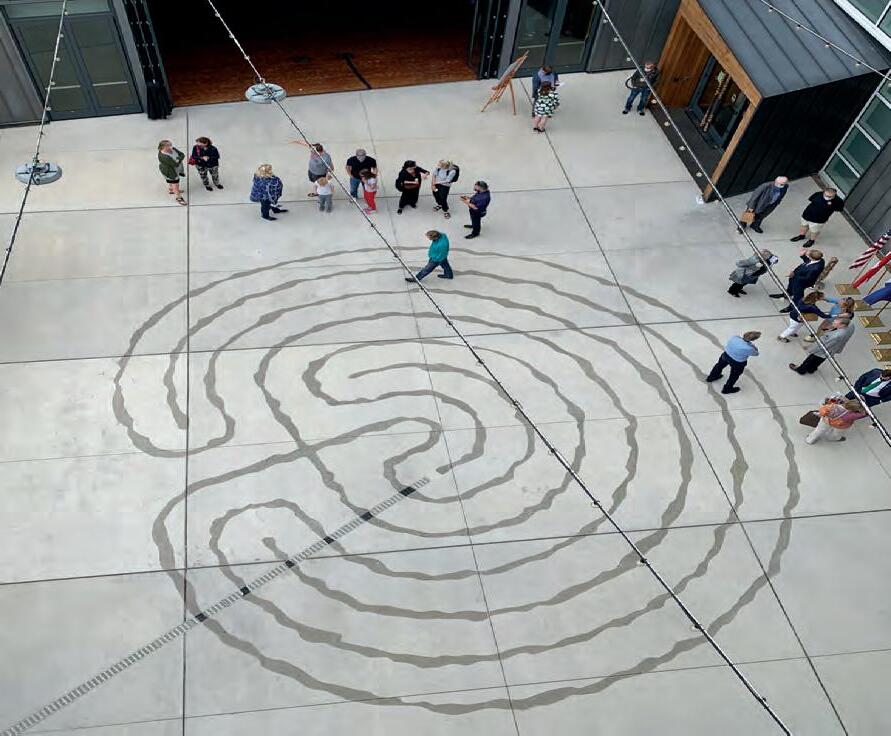
Huether advised the Museum’s team on the form and the technique used to etch the final design on the Museum’s Fisherman’s Sun Terrace. The finished labyrinth was unveiled on August 21, 2021, at a ceremony with Huether; Robert O’Driscoll, the Consul General of Ireland to the Western United States; Helge Marstrander; Consul/Deputy Chief of Mission and Royal Norwegian Consulate General in San Francisco, Dr. Terje Leiren, Museum Trustee and Professor Emeritus of Scandinavian Studies at the University of Washington; and Jeanne Kohl-Welles, King County Councilmember.


Unveiling ceremony with Robert O’Driscoll, Consul General of Ireland in San Francisco and Jeanne Kohl-Welles, King County Councilmember (first row); and Dr. Terje Leiren, Board President Tom Malone, Helge Marstrander, Consul/Deputy Chief of Mission, Royal Norwegian Consulate, artist Gordon Huether, and Executive Director/CEO Eric Nelson (second row)
Balcony view of the Labyrinth and guests in August Museum visitor and dog Teddy walking the Labyrinth in winter Etching in the labyrinth design last summer

Between 1860 and 1879, the United States conducted several major geological surveys from the Missouri River westward to California’s Pacific Coast. Through these surveys, the Government sought to learn as much as possible about the West: what the land looked like, how it could best be traversed, and the opportunities it offered in terms of trade and resources. Taking part in the surveys—in reality, ambitious and costly expeditions with myriad goals—were a number of photographers. Carleton Watkins, Timothy O’Sullivan, William Henry Jackson, John “Jack” Hillers, and others joined larger teams of men and mules to cross boundless plains and climb craggy cliffs, all the while documenting the landscape with their boxy wooden cameras and glass plate negatives.

Meanwhile, across a continent and beyond an ocean, Scandinavian photographers including Marcus Selmer, Knud Knudsen, and Axel Lindahl were also traveling through similarly rugged terrain in Norway, following narrow fjords and scaling steep mountains. Alone, or perhaps accompanied by a local carriage boy, they were capturing “Photographic Views of the grandest and most famous Scenery,” prospects they would later sell to tourists via their own businesses, through book sellers and tourist agencies, and, in the case of Knudsen, by way of a wide-reaching international network of buyers.

During the last decades of the nineteenth-century, these mostly self-taught landscape photographers on both sides of the Atlantic created an astounding body of work: thousands upon thousands of images documenting the American and Norwegian landscapes for posterity. One image, Knudsen’s View from Udsigten [the Lookout] in Oddedalen Valley, Hardanger, depicts an expansive view of a snow-capped mountain range. A carriage road, framed by boulders for safe passage, crosses the foreground diagonally. To the side of the road, a large black mass is actually the photographer’s darkroom tent: his work-station and laboratory when out in the field. The carriage above it is stacked with just some of his necessary luggage, including crates with chemicals, glass plates, and a large bundle that may contain his personal belongings. Further into the middleground, a man has walked up a short path from the main road. He turns his back away from the picturesque overlook, as if to emphasize the importance of the photographer’s presence at the scene.

Knudsen was not alone in including signs of his occupation in his photographs. In the United States, for instance, Jack Hillers created a stunning image at Virgin River, Zion Canyon. In this circular crop from a mammoth plate negative, a camera is placed prominently in the lower left corner of the composition, as if ready


to capture the very view we are looking at in the photograph. A large rock at the center of the image mirrors the jagged line of mountains further afield, underscoring the ostensibly untouched nature in the area that is now Zion National Park. At a time when we all carry (phone) cameras in our pockets, it’s difficult to imagine the technical challenges of setting up the photographic equipment and handling large and fragile mammoth glass plates. Like Knudsen, Hillers inserts the means of making a photograph into the scene’s spectacular beauty.
The photographers’ aesthetic impulses and careful attention to composition must also be seen in relation to their utilitarian and commercial contexts. The uses for these nineteenth-century photographs were manifold: as evidence of the state of the nation, prompts for infrastructure development, and mementos of landscape to keep in albums, as stereo views, or decoration on the wall in one’s own home. Across the West and Toward the North considers a historical moment when vast regions were first surveyed, exploited, and photographed in the United States and Norway. The exhibition is the first attempt to investigate the many, perhaps surprising, intersections between Norwegian and American nineteenth-century landscape photography. The two nations are culturally, politically, and geographically very different from each other, yet the photographers’ records testify to shared interests and concerns. On the one hand, their photographic practices demonstrate profound awe for the advances and inventions that made possible infrastructure expansion, land development, and new industries; on the other, the images reflect a nostalgia for the loss of seemingly wild and unspoiled nature in the face of increasing industrialization.
If the photographers’ fascinations found parallels on both sides of the Atlantic, so did their omissions and biases. Each country was—and is—home to diverse Indigenous populations whose
relationship with and use of the land had long histories, yet their perspectives are largely lacking in the many prints, albums, and stereoscopic cards produced for the surveys and by the commercial photographers. Even so, Indigenous peoples were recurring subjects for the photographers included in Across the West and Toward the North, in images depicting ancient pueblos in the US or as self-aware subjects acting out Indigeneity in camps catering to curious tourists in Norway. Growing out of traditional reindeer herding practices, these semi-permanent camps of traditional dwellings and animal enclosures were but one minor way humans changed the landscape throughout the period. Of far further impact were railway and road construction projects, as well as the development of industries, including large-scale agriculture, mines, and hydroelectric power stations. While many of the images in Across the West depict nature as “pristine,” the photographers also documented industrial progress and advances: developments that we now consider anew with a view to climate change and ever-increasing pressure upon “wild” landscapes.
Many of the best-known American photographers in the US were born elsewhere, including Timothy O’Sullivan, Charles R. Savage, Eadweard Muybridge, Frederick Monsen, and notably Anders Beer Wilse. In 1900, Wilse, who had spent his early adult years in the US, returned to Norway and established a successful photographic business, including as a prolific photographer of landscape views for the newest medium, the picture postcard. Wilse had co-owned a photographic business in Seattle from 1897, and also took part in the Kimball expedition to the area surrounding Yellowstone National Park as a surveyor and photographer. He arrived in his native Norway with an eagerness to find new ways of portraying the national landscape and with a typically American
sense of business and entrepreneurship that would make him the most successful photographer in Norway. Of the photographers included in Across the West, Wilse perhaps best exemplifies the transnational relationships and influences that contributed to the development of early landscape photography in Norway and the US alike.
Though few of the prolific traveling photographers ever met in person, they would have encountered each other’s work through sales albums, in magic lantern lectures, and at World’s Fairs. Here, visitors could examine the Norwegian and American views in much the same way as they are presented in the exhibition at the National Nordic Museum: beautiful, faraway lands with striking similarities.
The exhibition has been made possible in part by the Nysether Family Foundation.
IMAGES FEATURED:
2.
3.
Their gift to the National Nordic Museum includes pieces by Danish artists Tobias Møhl (b. 1970) and Stig Persson (b. 1960), and Swedish artists Bertil Vallien (b. 1938) and Ulrica Hydman Vallien (1938–2018). These additions buttress the Museum’s holdings of Nordic glass created by artists including Gunnar Cyrén (1931–2013), Edvard Hald (1883–1980), and Tapio Wirkkala (1915–1985). In 2018, the Museum aquired Migration, a stained-glass installation from Faroese glass artist Tróndur Patursson, to become a permanent fixture of its iconic Fjord Hall. Visitors will learn more about the Patursson piece, the Pruzan gifts, and other examples of art glass that have entered the collection since 2018 in the small exhibition New Nordic Glass: Recent Acquisitions (February 12–May 29, 2022).

Pacific Northwest sculptor Ron Petty (b. 1939) donated materials that document the 1986 - 88 execution and dedication of the Seattle Fishermen’s Memorial at Seattle Fishermen’s Terminal. The gift includes correspondence related to the design competition from the announcement of the contest to Petty’s selection and the execution of the piece, blueprints, the twenty-eight-inch bronze maquette presented to the Seattle Fishermen’s Memorial Artist Selection Committee for the competition, the wood-andputty model used to illustrate the design concept in the open competition phase, a full-sized fiberglass fabrication model of the sculpted fish, and posters and brochures celebrating the unveiling.

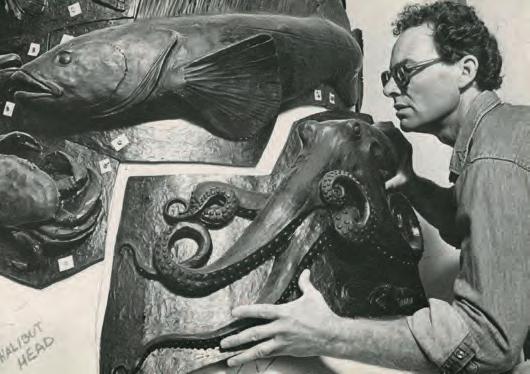
In 2021, the National Nordic Museum continued to add to its holdings of nearly 80,000 objects. Several important additions will soon be available to visitors of its library (called the Collections Resource Center) and galleries through small, temporary exhibitions.
Seattle-based art collectors Herb and Lucy Pruzan generously donated five exceptional pieces of Nordic glass created by Nordic artists between 1988 and 2008. The Pruzans, who began collecting as newlyweds, possess a keen eye for art. They acquired the work of Northwest artists in a range of media, and they developed thoughtful collections of art glass and ceramics by local and international artists.
 by Leslie Anne Anderson, Director of Collections, Exhibitions, and Programs
by Leslie Anne Anderson, Director of Collections, Exhibitions, and Programs
Researchers of Nordic design will be excited to learn that William C. Miller, Professor and Dean Emeritus of the College of Architecture + Planning at the University of Utah, has gifted the Museum his library devoted to Nordic art and architecture. Miller, who is also a Distinguished Professor of the Association of Collegiate Schools of Architecture (ACSA), has published and lectured regularly on the Finnish architect Alvar Aalto (1898–1976) and modern Scandinavian architecture. His books include Alvar Aalto: An Annotated Bibliography (1984) and Nordic Modernism: Scandinavian Architecture, 1890–1915 (2017). The library comprises over 500 books, 150 periodicals, and 100 pieces of ephemera with an emphasis on Alvar Aalto and Finnish architecture and design. It is a transformational collection that will expand understanding of the subject matter. Coinciding with public access to these materials in the Collections Resource Center, the Museum will host a new five-part program series funded by the Nordic Council of Ministers and Artsfund to be launched in Spring 2022.
Dr. Nathaniel Hong, a professor at Olympic College in Bremerton, recently donated his personal library of books on or dating to the occupation of Denmark. There are rare materials, such as sixty-eight books and eighty-eight original copies of newspapers published illegally during World War II and a large scrapbook that includes artifacts that illustrate the story of the German occupation of Denmark.
Dr. Hong conducted extensive research on the occupation of Denmark by Nazi Germany, which was published in his 2012 book Occupied and contextualizes the tensions between the two forces within Denmark’s cultural, economic, and social history. Dr. Hong’s gift complements key acquisitions made in recent years, such as a cotton armband worn by a member of the Danish resistance movement to legitimize their efforts as an army under the standards of the Geneva Convention.
Don Ibsen, Jr., son of Ballard-based waterski pioneer and manufacturer Don Ibsen, Sr. (1910–1993), generously transferred the Ibsen Waterski Corporate Archives to the Museum. Ibsen was among the first in the country to develop the sport of water skiing in the 1920s. He was an indefatigable promoter of it through the following decades. This collection traces the regional, national, and international history of the sport through photographs, news clippings, correspondence, programs and promotional materials from the 1920s until 1980, as well as Ibsen waterskis.
These recent acquisitions will raise the profile of the Museum as a center for the study of Nordic and Nordic American art and history. Providing further documentation of these collections, donors Hong, Ibsen, Miller, and Petty also
served as narrators for the Museum’s oral history program, and their interviews are available to researchers through our online database. The Museum will also offer related programming to inspire further exploration of these important donations through lectures and panel discussions featuring experts in the field.
IMAGES FEATURED ON PREVIOUS PAGE: Stig Persson, (b. 1960 in Copenhagen), Layers No. 2, 2009. Tobias Møhl, (b. 1970 in Aalborg), Nest Collection, 2008.
Image of the Fishermen’s Memorial, Fishermen’s Wharf, Seattle, Washington.
Image of Ron Petty from a postcard titled “Fishermen’s Memorial Work in Progress,” photo by Kurt Smith, 1986.
Image of Don Ibsen on water skis is from Life Magazine, August 12, 1957, photo by Marshall Lockman.

Art Walks – 2nd Sat each month, year-round, 5-8 pm
Poulsbo Historical Museums –Daily, Call for hours



historicdowntownpoulsbo.com


Girls Night Out –1st Wed in May
St. Paddy’s Beer Run –Sun before St. Patrick's Day
Syttende Mai (17th of May) Festivities – Mid-May, SON Viking Fest – 3rd weekend in May
Midsommer – 3rd Sat in June, SON/Waterfront Park

Fireworks on the Fjord –July 3rd, Liberty Bay, dusk Concerts by the Bay – Every Tues, July & Aug, 6:30 pm
Poulsbo Arts Festival – 3rd weekend in Aug
Poulsbo Beer Run – Oct Downtown Safe Trick or Treat –Oct 31st, 4-6 pm

Shop Small Saturday –Sat a er Thanksgiving
Free Visits with our Nordic Santa – Sat & Sun
Thanksgiving-Christmas
Julefest, Nordic Market & Bonfire – 1st Sat in Dec, SON
Lighted Ships Parade – 2nd Sat in Dec, 5:15 pm, Waterfront
Lutefisk & Meatball Dinner –last Sat in Jan, SON
In 2021, the National Nordic Museum received a generous grant from the Snoqualmie Indian Tribe to launch phase two of the oral history initiative Interwoven: The Blended Heritage of Nordics and Native Peoples, which collects the lived experiences of Native peoples with Nordic ancestry.
Interwoven began in 2016 and comprises seventeen oral histories with cultural leaders from several tribes in Washington State and Canada, including the Tlingit, Iñupiat, and Duwamish. Interwoven has also been the subject of two symposia, one in 2018 at the National Nordic Museum, and one in 2019 at the Hibulb Cultural Center. In the past year, Suquamish Tribe Chairman Leonard Forsman, Suquamish Tribe Executive Director Scott Crowell, and Pacific Sámi Searvi board member A. Indie O’Sidhe, who has both Sámi and Anishinaabe heritage, have augmented this project with their narrations.

The goal of Interwoven has been to preserve interviews for public exploration and to create lasting relationships with members of the Native American community so that the Museum can better serve the diverse population of the Pacific Northwest. Recently, an initiative led by the Curatorial Department has also ensured that the oral history collection is more representative of the Sámi experience.
Member of the Sámi Parliament of Norway, Sandra Andersen Eira, was interviewed. Overseen by the Curatorial Department, the Nordic American Voices volunteers are contributing to this project by interviewing Washington residents with Sámi heritage.

These quotes exemplify the stories we preserve with this project, with themes that include: connection, heritage, tradition, language, culture, craft, and enacting change, both locally and globally.
“I think [the Sámi and Anishinaabe heritage] was a big way that people in my family connected...because there are a lot of the same values and ideals, and just ways of living that are shared. I think that was really good groundwork for my parents to bond over, and my grandparents, and my great-grandparents.
The grant from the Snoqualmie Indian Tribe will support the expansion of Interwoven to incorporate more narrators with Nordic and African, Asian, or Latin American heritage. It will cover costs for filming and transcribing the interviews, which will be accessible through the Museum’s online portal and discoverable to a global audience. Some of the interviews collected will be featured in the Museum’s orientation video in the Nordic Journeys core exhibition.
The video is a compilation of responses to the question: “What does it mean to be ‘Nordic’?” Playwright and performance artist Camara Lundestad Joof, University of Washington Burke Museum Curator and MacArthur Fellow Dr. Sven Haakanson, and Pacific Lutheran University Professor Dr. Troy Storfjell are among the individuals who are participating in this new video project. With these important additions, the video will speak to bicultural identity and the varied experiences of the many communities with ties to the Nordic region.
The Museum’s main curatorial objective is to present inclusive narratives and to foster a welcoming environment throughout the visitor experience, from beginning to end.
[There are] Sámi people [in the Pacific Northwest], as well…and being on the Pacific Sámi Searvi helps me stay in touch with that, and learn more about that while being away from my family. The Anishinaabe heritage is a little bit harder to stay connected to, because so much of the culture is about the lakes and waterways, and manoomin, which is wild rice, which really only grows well [in the upper Midwest]. A lot of the plant knowledge is location-specific. But I try to kind of keep doing things, like going out hiking in the woods…we do mushroom-foraging, to get outside, and get that similar kind of feel.”
“I think language is so precious to a culture. Language is the heart of a culture. For example, in the Salish dialect that my tribe has, the word for your relatives is the same word that we use for animals. So, what you can infer from that is there is a relationship between animals and these people— that we view animals as our relatives. I think in every language, you’ll find words like that, that teach you so much about the core of that culture. I think preservation of our own languages is important. From the Nordic side, I think preservation of Icelandic is incredibly important. I know with a lot of tourism, Icelandic people are speaking more and more English, but I think it’s important to preserve Icelandic. It’s a language that is older than so many other languages. It’s a connection to the past, and the people that we were.”
See what’s in store…
Nordic housewares, artisan jewelry, small-batch candies, best-selling books, Scandinavian toys, and more in the Museum Store

Here’s a soup that tastes great on a cold day and can be made in a slow cooker. We use dried green peas, but dried yellow peas work well, too.
Makes 6 servings
INGREDIENTS
2 cups dried split peas
4 cups cold water
4 cups cold chicken stock
2 onions, thinly sliced Salt and pepper, to taste
2 T butter
3 celery stalks, chopped 3 carrots, chopped 1 potato, peeled and diced ⁄2 lb ham, diced

Over the years, it’s been a tradition for Members to gather for hot soup and the coolest Nordic Films. When many of our movie offerings went online, the pairing continued informally at homes across the country. In 2021, the film programs once again returned to the Museum to sold-out audiences. The Sámi Film Fest in the fall of 2021 at the Museum and online was a wonderful success, as were other movies last year in Osberg
Great Hall, including Taste of Iceland’s The Hero’s Journey to the Third Pole. While February’s Nordic Lights Film Festival remained virtual in 2021 and 2022, plans are being made to bring it back to Ballard in 2023.
Throughout the year, audiences snapped up the Museum’s cookbook Soup & Cinema, which went into its third printing in 2022. Check the website for more film programs in 2022 at nordicmuseum.org/calendar as you enjoy a bowl of soup!
nordicmuseum.org/museumstore
Recipe from: Soup & Cinema Concept and text: Stina Cowan Photography: Adam L. Allan-Spencer
1. In a large pot, cover peas with cold water and chicken stock. Soak overnight.
2 . Once peas have soaked, add onion, salt, and pepper.
3. Cover, bring to boil, and then simmer for 90 minutes, stirring occasionally.
4 . In a separate pan, sauté vegetables in butter. Then, add vegetables to soup.
5. Add diced ham.
6. Cook slowly, uncovered, for 30 minutes or until vegetables are tender.


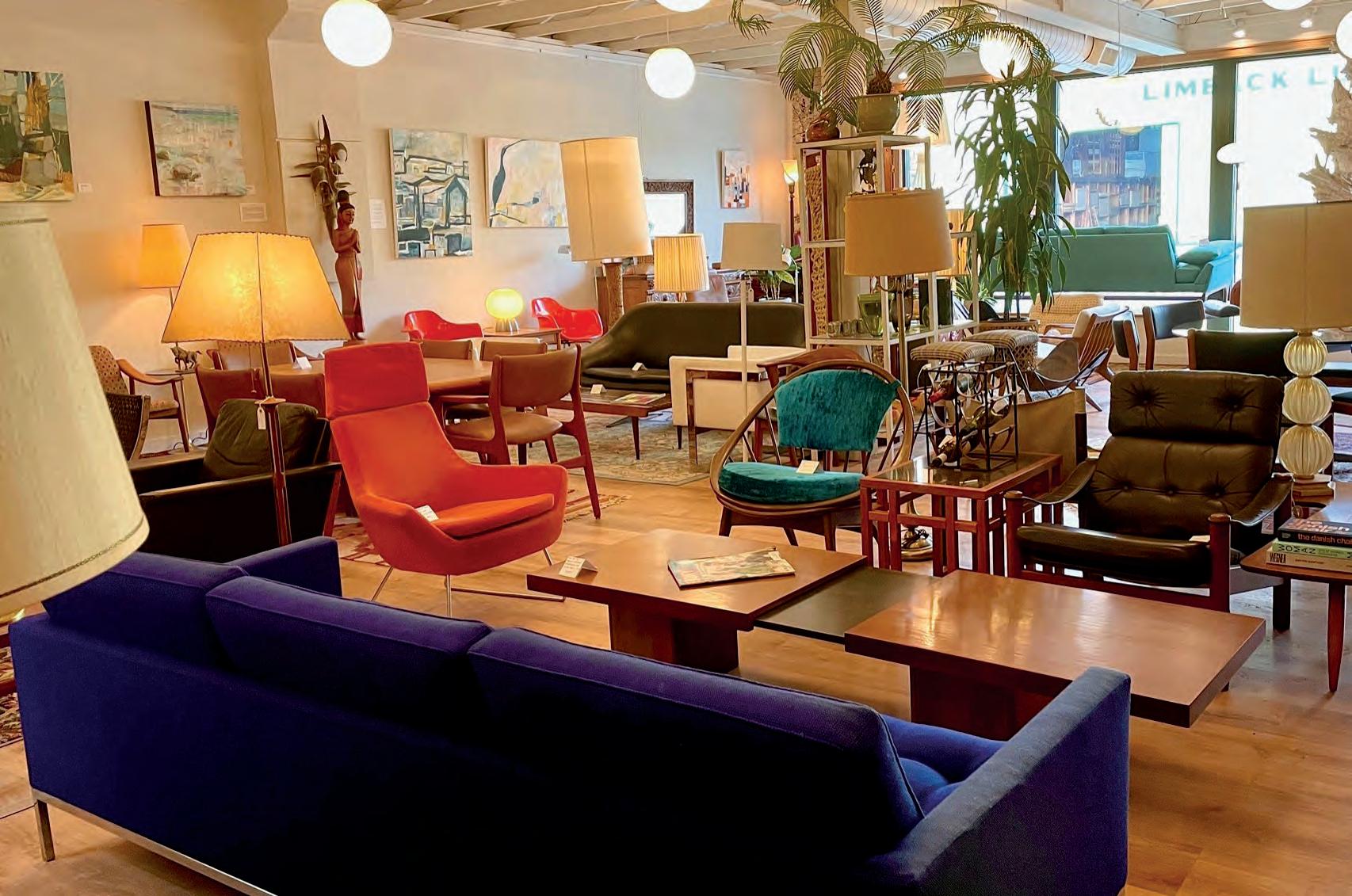
Nestled next door to the Museum, Ballard’s Nordic heritage shines bright in the vintage treasure trove that is Sparklebarn, a furniture gallery epitomizing the minimalism and elegance that is Scandinavian design.

A resident of the neighborhood for over 20 years, owner Shane Bastian didn’t always anticipate ending up in the business of furniture restoration—but it has always been in his roots. Growing up in Clearview, near Snohomish, the people in his life were constantly laying the groundwork for what would become his adult self’s passion.
By Carly Hinman“It’s sort of an inherited family thing,” he says, of his relatives’ affinity for workshops—from his carpenter uncle Elmer’s space down the road, to his own father’s knack for salvaging the old and transforming it into something new and useful.
One might argue that it’s this background in upcycling that allows Shane’s business to fit so snugly into the historically Scandinavian Ballard, when sustainability and innovation are highly valued in the culture its origins are steeped in.
As far as aesthetics are concerned, perhaps nothing represents the Nordic design tenants so well as the Danish furniture in Sparklebarn’s showroom. From Børge Morgensen’s
revolutionary “Danish modern”, to the functional lines and Windsor-esque beauty of Kofod Larsen, Danish design is all about eliminating the unnecessary, as well as finding the beauty in simplicity. Shane counts the shift in values after World War II to be a particular turning point, when prominent furniture makers began to reflect the efficiency, durability, and hard work of the post-war era in their creations.
“There wasn’t extra time to be cool,” says Shane.
Additionally, he points to the environmental parallels between the Nordic region and the Pacific Northwest, and how the natural similarities between the two affects its residents’ aesthetic preferences.
“We’re inside nine months of the year,” he says. “People want to be surrounded by things that are comfortable.”
Sparklebarn is open every day of the week except Monday and Tuesday, and visitors are encouraged to stop in after their Museum visit to fully appreciate Ballard’s Scandinavian (and vintage) core. Plus, don’t forget to take a peek in the back, where you might just catch a glimpse of the magic in motion: Shane has a workshop of his own now, and it’s entirely open to the public.

From December 2022 until March 2023, the National Nordic Museum will present Mygration, an exhibition of works by Tomas Colbengtson and Stina Folkebrant. For this show, the artists selected an episode at the intersection of Sámi and American history as the source of their inspiration, and they created a collaborative, immersive installation in response to it. In 1894 and 1898, Dr. Sheldon Jackson, the General Agent of Education in Alaska, recommended that the United States Government invite Sámi herders to Alaska for the purpose of teaching reindeer husbandry to Alaska Native Peoples. The herders and reindeer traveled to Alaska by way of Seattle. Upon the expiration of their contract in 1900, some participants remained and joined the Gold Rush, while others returned to Sápmi.
The work of Sámi artist Colbengtson and Swedish artist Folkebrant examines this narrative, exploring issues of migration, herd mentality, time, and forgotten past. For the Mygration exhibition, Colbengtson selected and printed archival photos of Sámi immigrants, which are paired with Folkebrant’s large-scale paintings of the eight seasons of the mountain world, illustrating the Sámi concept of time and the life of the reindeer. The paintings are hung in a circle with the photographs at center, inviting the visitor to become immersed in a panoramic image. Additionally, the Museum has commissioned Folkebrant, a muralist, to create a piece related to the exhibition’s theme on the façade of a building on its campus. I initiated a conversation with Colbengtson and Folkebrant to discuss their work on this exhibition, as well as their efforts to raise awareness of this important story.
LAA: Leslie Anne Anderson, Director of Collections, Exhibitions, and Programs
TC: Tomas Colbengtson
SF: Stina Folkebrant
LAA: Mygration is inspired by a chapter of history that is not often taught or published. In fact, it may be new information to many Americans who visit or read about the exhibition. When did you first learn about the of immigration of Sámi people to Alaska and the Pacific Northwest? What
inspired your investigation of the past and your collaboration on this exhibition?
TC: Ten years ago, a Yupik woman Helen Mary Margret moved with her family to my home village under the polar circle in Tärna, Sweden. Helen explained that her Sámi great-grandfather, Per Spein, had migrated together with other Sámi families and their reindeer from Finnmark in Norway to Alaska in the early 1900s. Their travels took them from Tromsø via New Jersey to Alaska with the purpose of introducing reindeer herding to Alaska Native peoples in the Bering Strait region. I was slightly aware of this historic enterprise, but I had not given it further thought until her arrival.
SF: I first learned about this story two years ago, when the Sámi television program “Ođđasat” aired a documentary called From Sápmi to Alaska I was completely surprised and overwhelmed. I wanted to know more about it. It also made me angry that this part of history was omitted from the narrative about Swedish mass-immigration to the United States that is taught in schools. This is an interesting story that merits attention.
I was also inspired by the incredible amount of effort and strength displayed by both humans and reindeers that my mind began to sketch out ideas. As an artist, I focus on depicting animals in nature. Painting reindeers only would not allow me to tell the full story, so I started thinking about a collaboration. I had met Tomas Colbengtson a few times and, when I saw that our [artist] residencies would overlap with each other, I started thinking. The following night, I had a vivid dream, in which I saw the whole exhibition with our art installed together. In the morning, I drew it and sent a message to Tomas to gauge his interest in collaborating on an exhibition. I was so happy that he said yes! From there, we started to work with the material.
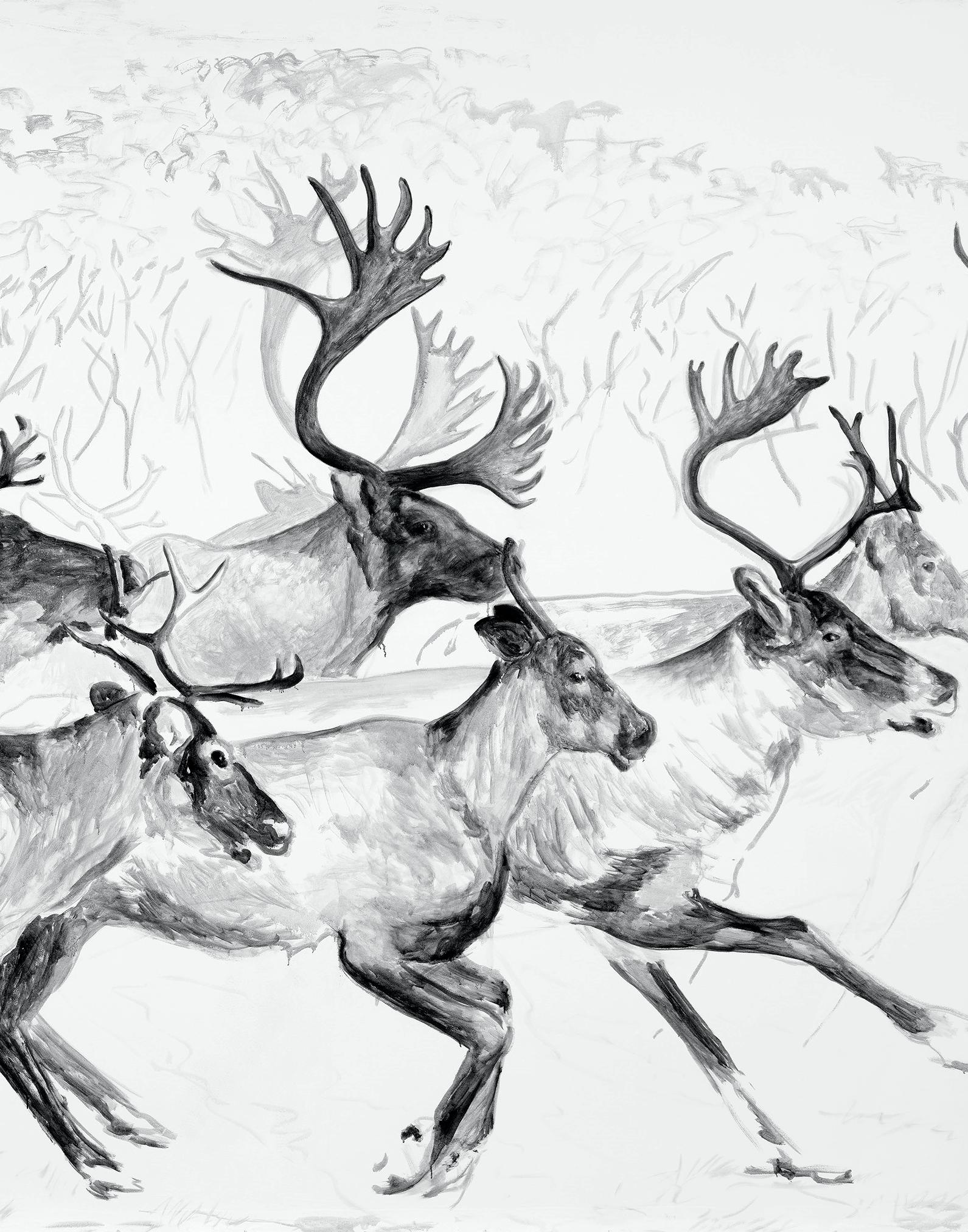
I read and watched many films on reindeers. This project began during the pandemic; travel to the north to see the reindeer in person was impossible. I had to get to know them by using my imagination. My goal was to feel the reindeers’ spirit and to try to mediate their experiences.
My paintings are not scientific studies, they are works of art. I was inspired by the eight seasons in the north of Sweden. That´s why I executed eight paintings of reindeers. The paintings are three meters high by four-and-a-half meters wide, so that the animals are life-sized. However, I sometimes paint them slightly bigger or smaller depending on the feeling I want to communicate. Tomas and worked separately in studios and occasionally, together in my studio, where we put up parts of the exhibition to see how our works relate to each other.
LAA: Mygration explores several themes—emigration, herd mentality, cycles, time, and forgotten histories. How were these themes identified?
SF: Tomas grew up on the slope of Åeriel stoerre vaerie (Southern big/great/vast mountain). My family and have spent much of our time on the mountain, the source of our livelihood. The vast mountain area is central to our lives throughout the seasons. My frame of reference and starting point are on this mountain, especially as it relates to the cycles of life. Every late April, the reindeer return from feeding on grass close to the Baltic coast, moving up the Stoerrie vaerie to give birth to their calves on the snow. Every ten years, there is an invasion of millions of lemmings. Every thirty years, there is an invasion of millions of Geometridae, caterpillars that consume the birch leaves on the mountain slopes. Every fifty years, there is an invasion of millions of Gräsmask (grass worms).
The themes of cycles, time, emigration, herd mentality, and forgotten histories emerged as we worked with this story. Tomas is Sámi and Swedish, and I am Swedish. We discussed these themes from our own perspectives. The themes are universal. The meaning varies depending on the viewer. It’s in the eye and mind of the beholder.
LAA: Tomas, what role did research and archival material play in the conception of your work? Which techniques of the present do you employ to reference the past?
TC: Much of Sámi history has been hidden away from the public eye due to discriminatory policies based on race, and there is no comprehensive written history of the Sámi people. Therefore, I feel that my art fills a void of knowledge both for the public, but also for the Sámi themselves, initiating a process of healing and re-creating what we, the Sámi, had lost. I am in search of authentic Sámi life, and I must look beyond the images illustrating racial stereotypes of Sámi and other indigenous people from the nineteenth century. Therefore, I often use archival photographs of Sámi from the middle of the nineteenth century up to 1940.
LAA: Stina, would you describe how the passage of time is communicated in your murals? How do studies of nature inform your process?
SF: The seasons tell us about the time, its continuity and ephemerality. We see the passage of time in the seasons. In winter, snowflakes cool the landscape and in spring, the snow melts. In my paintings, I want to depict the lives of the reindeer across the seasons. For example, in early pre-spring, reindeer calves are born. My interpretation of the reindeer in the different seasons are from an artistic point of view. I also wanted to paint life with both happiness and sadness. In nature, life and death are ever-present. To show that, I have painted bears and eagles as threats when the calf is born, but also black crows as they are a bad omen in the Sámi tradition. Birds tell me about the air that surrounds us, and they give the picture motion. I usually paint birds, and the black crow is one of my favorites. The study of nature gives me the keys to the movement of time.
LAA: Would you describe the installation of your work? How is meaning conveyed through the visitors’ experience of Mygration?
SF and TC: The exhibition captures the shadows of life. Photography can be described as a frozen shadow. Using Plato’s idea of shadows [in the Republic’s allegory of the cave] as our cognition of the world. We collect past and present shadows in the exhibition, using painting on canvas, prints on mobile transparent film, and a double-sided mirror to catch the “shadows”
visitors cast. Visitors to Mygration will walk into a scene, where they play a part of the art installation. It´s possible to walk around Tomas’s pieces in plexiglass and see other visitors through them, and Stina’s painting encircling them. The exhibition invites the visitor to interact with it on several layers. The visitors’ movement around the artworks allow them to experience time on their own terms.
LAA: Mygration opened at Ájtte, the Swedish Mountain and Sámi Museum, in Jokkmokk, before the National Nordic Museum in Seattle. What was response to this exhibition in Sápmi? What do you hope that visitors will take away from the exhibition?


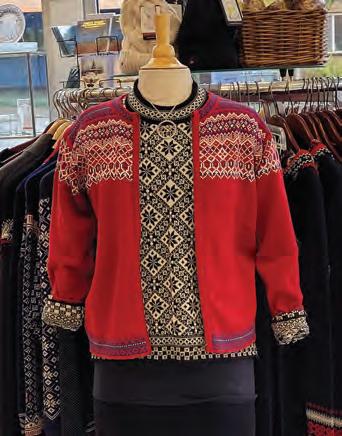

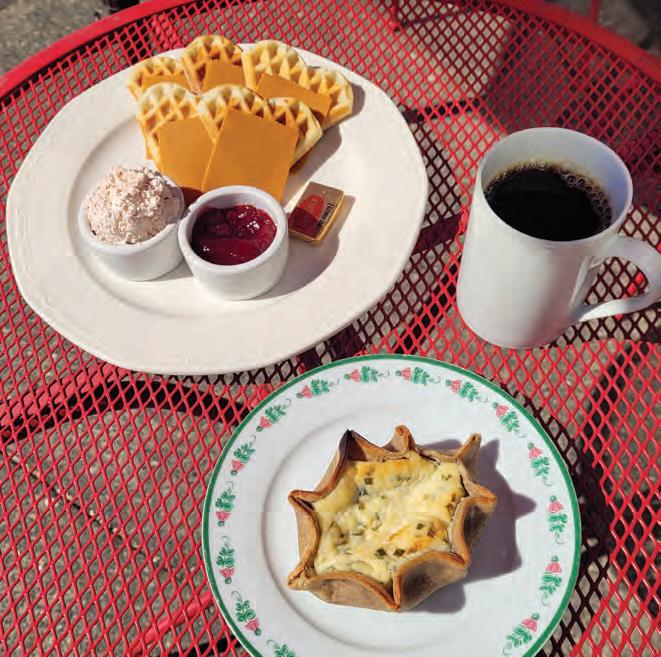
SF and TC: Mygration premiered at Ájtte Museum, and it exceeded our expectations in terms of attendance and response. The exhibition was appreciated immensely by the community. We hope that visitors feel the passage of time by looking at the old photographs of people that could be
you and me. The paintings convey herd mentality that extends to the human experience, and it may prompt people to think about human behavior. However, another takeaway is that we are also part of nature, and we must respect it.
LAA: Stina, you will be painting a mural on the Museum’s campus that is accessible to the public prior to the exhibition. How will this mural relate to the exhibition?

SF: My mural will share the experience of being in northern Sweden by depicting the reindeer, bears, and birds in the mountainous landscape. It will be a glimpse into the world of the Swedish reindeer.
Mygration: Tomas Colbengtson and Stina Folkebrant will be open from December 9, 2022, through March 5, 2023, in the Museum’s Barbro Osher Gallery.
The exhibition has been made possible in part by Krueger Sheet Metal and Pacific Sámi Searvi.
 IMAGES FEATURED: Tomas Colbengtson and Stina Folkebrant, Mygration installation (2021), Ájtte, the Swedish Mountain and Sámi Museum, in Jokkmokk
IMAGES FEATURED: Tomas Colbengtson and Stina Folkebrant, Mygration installation (2021), Ájtte, the Swedish Mountain and Sámi Museum, in Jokkmokk


Now in its 36th year the Museum’s most enchanting evening event returns to the Hyatt Regency Seattle in May. The Northern Lights Auktion chairs Elisabeth Bodal, Krystn Nesselquist, and Sofia Taylor promise plenty of bell ringing, many toasts, and, of course, some fabulous packages to be auctioned off to the highest bidder. All proceeds go towards supporting the Museum’s world-class exhibitions, popular educational programs, and essential operations.
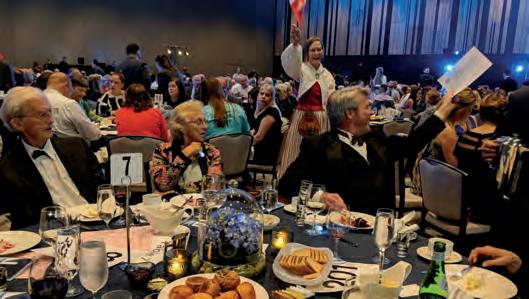
A legendary event in the community, this year’s Northern Lights Auktion will honor the founding Nordic Heritage Museum Director Marianne Forssblad, who will receive the Allan Osberg Award for Distinguished Service. As she noted in her own history of the Museum’s first 25 years, Forssblad started her tenure at the Museum in 1980, shuttling between it and her position at the University of Washington’s Department of Scandinavian Studies, but quickly became the Museum’s full-time director. “The tasks at hand were to build more exhibits, arrange programs, develop membership, and try to keep the Museum solvent,” wrote Forssblad about those early years. All of which she accomplished, starting with the opening display of “The Nordic Settlers in The Pacific Northwest” in April 1980.
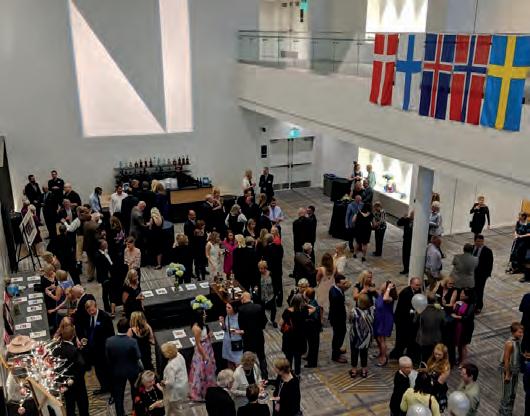
The 2022 Northern Lights Auktion will be held on May 21. Further information can be found at nordicmuseum.org/auktion

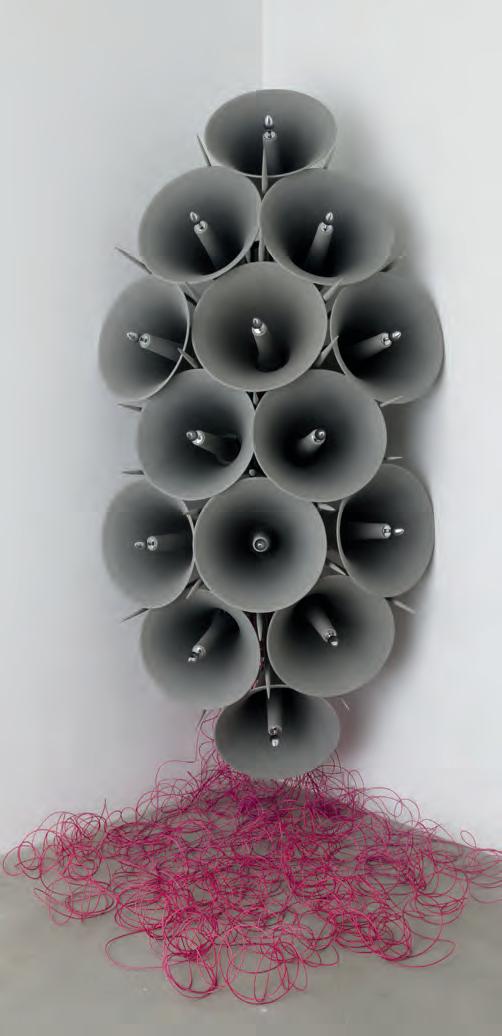 By Annie Dell’Aria, PhD
By Annie Dell’Aria, PhD
We tend to treat the gallery space as a container for isolated visual experiences—a non-place or “white cube” that provides a quiet, neutral site within which we move between individual artworks. Of course, galleries are hardly that. The gallery space is a particular kind of framing—an ideological technology of aesthetic encounter. Engaging a wider range of sensory experience—touch, smell, sound, and taste—transgresses the dominant, detached, and ocular mode of art consumption. Indeed many avant-garde practices of the last half-century have sought to disrupt the presumed antiseptic qualities of the white cube space through the multi-sensory bodily engagement of the viewer.
The installations of Icelandic artist and musician Jón Þór Birgisson, known as Jónsi, foreground sound within the white cube. In Jónsi’s installations, sound takes on textural, sculptural, and architectural dimensions in the gallery. Sounds also call to the senses in ways that blur the boundaries between them—triggering sensations on our skin, merging with smell, or engulfing space with bright white light. Synesthesia, a neurological condition where perceptions of sensory stimuli cross over into other senses, intrigued Modernist artists a century ago. For the Russian painter Wassily Kandinsky, such crossed pathways indicated a high degree of spiritual attunement, although the emphasis was always on color as the keyboard to the soul’s piano, and the spiritual in art was still locked within the picture frame. Installation prompts aesthetic experience beyond the frame in ways that both activate gallery space and engage the full body of the viewer.
Through experiences that occur over time and in space, Jónsi’s installations appeal to multiple senses, producing the kind of crossovers earlier artists dreamt of. Each room has its own signature scent, produced through the artist’s experimentation with perfume and often connecting to the natural world alluded to in each installation’s sonic landscape. Though scent is said to be tied most directly to memory, if there is a single keyboard to the soul in these works it is arguably Jónsi’s voice. While the artist’s voice is central to all three installations, it is a voice understood apart from speech. In much the same way that early Abstract painters divorced color from description, Jónsi’s vocalizations, both in the gallery and with the post-rock band Sigur Rós, defy lyrical expectations and often deny linguistic meaning. Jónsi’s signature falsetto and use of glossolalia (non-sense sounds) blur genders and prompt

deep affective engagement through voice devoid of communicative clarity. In the gallery, these vocalizations become dimensional—they are experienced directionally, they merge with sounds from the natural world or digital processing, and they emit or otherwise seem to evoke smell, light, and tactile sensations.
Í blóma (In bloom) features a corner assemblage of public address speakers with a bundle of wires beneath that allude to natural forms. The sculpture itself resembles the Foxglove flower, whose active ingredient has both toxic and medicinal uses. A rich aural tapestry merges Jónsi’s vocalizations with highly-processed field recordings, producing a sonic ambiguity that is virtually impossible to parse out—a striking contrast with the institutional address alluded to by the petals’ loudspeaker forms. Upon closer inspection, the reflective stamens protruding from each plastic petal are chrome butt plugs, alluding to bodily pleasure or pain and queering the
flower’s reproductive organ. The tonal shifts and reverberations ring through the white cube space, evoking Icelandic animism and Nordic geographies through sounds that become tactile.
Tactility also informs Svartalda (Dark wave). Jónsi’s voice, more intimate in this room, quite literally tries to pleasurably get under our skin. Eight hyper-directional speakers project ASMR sounds at various points throughout the gallery, while the black ceiling panels undulate slowly. Short for autonomous sensory meridian response, ASMR refers to a tingling feeling on one’s skin and mild sense of euphoria brought on by particular sensory stimuli, most often auditory whispers or delicate sounds of hands rubbing or tapping on a surface.
Jónsi’s ASMR vocalizations range from ocean sounds and breathing to a whispered Icelandic poem—perhaps the only spoken language in the exhibition—though again voice is not tied to linguistic communication. Voice is rather one
element in a dynamic spatial experience and intimately tactile encounter.
Hvítblinda (Whiteout) most directly recalls the emotional swells of Sigur Rós’s music and provides a sensory counterpoint to the intimate darkness and quiet whispers of the undulating ASMR chamber. A chorus of voices—all Jónsi’s— rings through the bright white cube, evoking the futuristic spaces of Stanley Kubrick’s 2001: A Space Odyssey and the light installations of James Turrell and Doug Wheeler. The non-place of the gallery—transformed through light installation and the rich layering of Jónsi’s signature falsetto— create a utopic space. Utopia, that perfect world aspired to by Modernist Abstraction, has its root in negation—a “no-place”—though it also frequently alludes to eutopia, or “good place.” Light and sound overtake the no-place of the gallery to produce an otherworldly eutopia experienced through our bodies.
If the place produced through these works happens through the body, it becomes impossible to capture these installations in words or reproductions—they must be sensed. Our embodied experience creates a dreamlike place as we linger in the gallery, one that overtakes our senses and crosses boundaries between them—perhaps finding new pathways to the soul and vibrations of the spirit.
A new site-specific installation by Jónsi is being developed for the National Nordic Museum and will open to the public in 2023.
IMAGES FEATURED:
Jónsi, blóma (In bloom), 2019. Sixteen-channel sound installation; fourteen PA speakers, electrical wiring, two speakers, metal, wood, acrylic paint, chrome butt plugs, cadaverine scent. Courtesy the artist and Tanya Bonakdar Gallery, New York / Los Angeles.
Jónsi, Hvítblinda (Whiteout), 2019. Twelve-channel sound installation; ten speakers, two subwoofers, aluminum, LED lighting, ozone scent. Courtesy the artist and Tanya Bonakdar Gallery, New York / Los Angeles
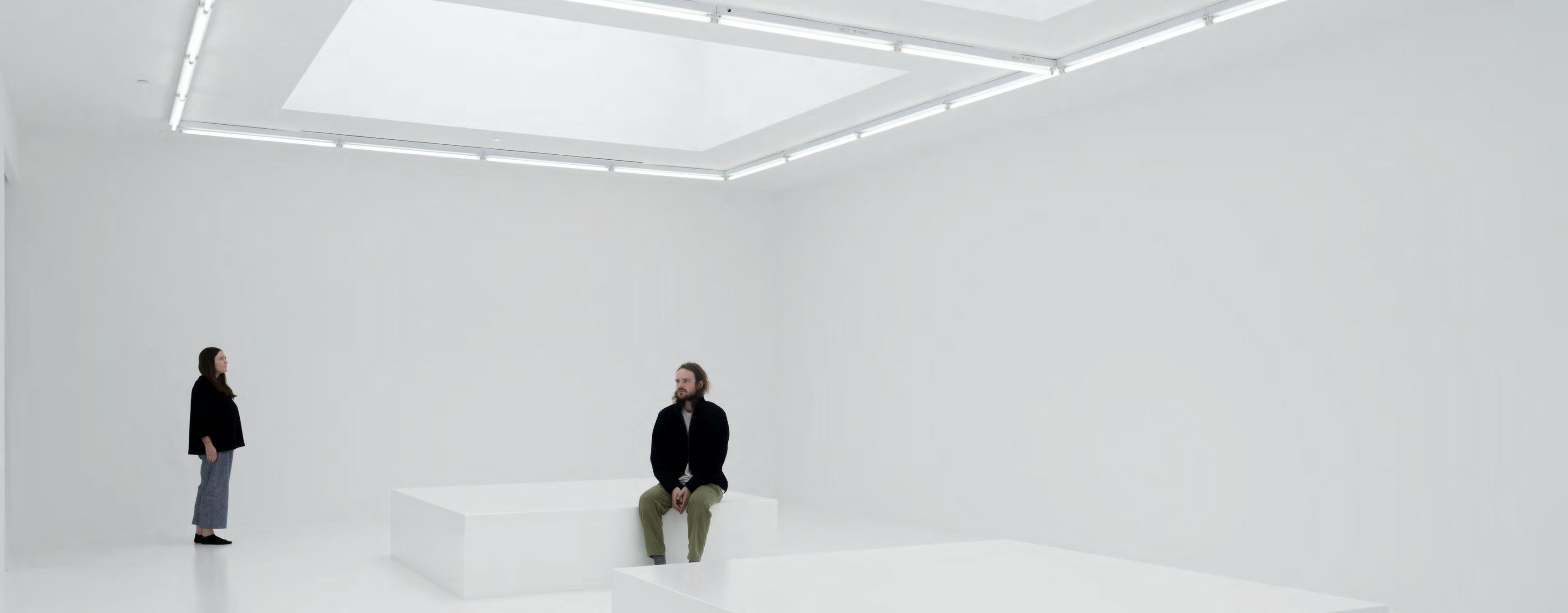
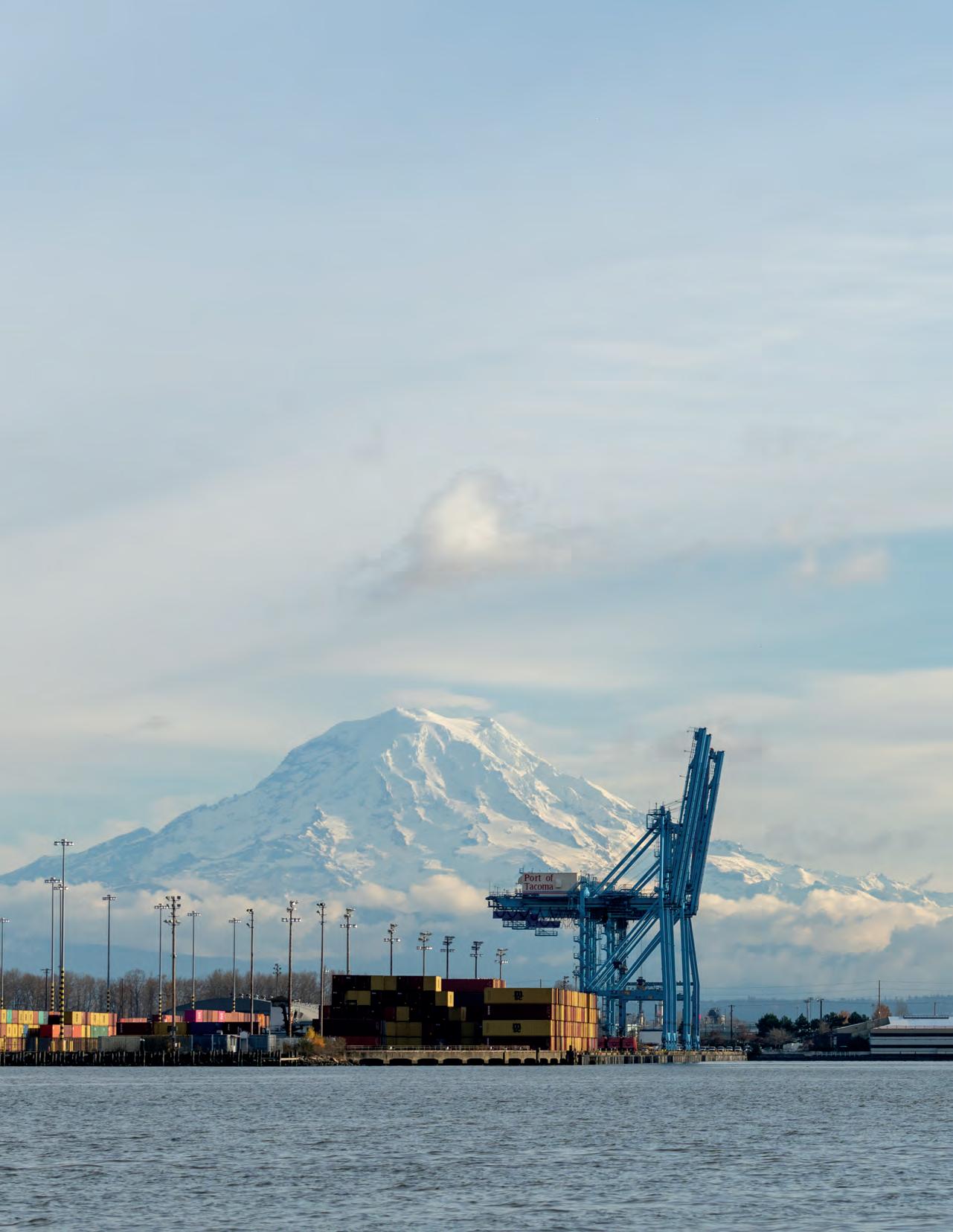 BY GREGORY SCUGGS
BY GREGORY SCUGGS
With the global supply chain in disarray and container ships moored in seldom-used Puget Sound anchorages, Washington Lieutenant Gov. Denny Heck signed a timely memorandum of understanding on November 4, 2021 with the government of Finland that included plans to build a so-called “smart port” in Tacoma as early as 2022.
The initial step in this process, a feasibility study for a 5G edge computing network in the Tacoma Tideflats area, was first reported by South Sound Business in September 2021.
“Port congestion is a bottleneck for the whole world economy, so there’s a huge incentive right now to ensure that port operations are optimized,” said Finnish Minister of Transport and Communications Timo Harakka. “We have several ports that already utilize 5G and advanced digital technology to operate their harbor operations in real time with their digital twin.”
Harakka is part of a trade delegation that visited the Ports of Seattle and Tacoma as well as Amazon, Boeing, and Microsoft last November. The MOU also includes the potential to collaborate on technology solutions related to transportation, forestry, and communication.

Finland’s largest port, HaminaKotka, is currently unloading cargo ships in half a day—far faster than clogged harbors elsewhere in the world. At the Ports of Seattle and Tacoma, it is currently “all hands on deck” to speed up shipments and deliveries.
“The Port of Tacoma and the Northwest Seaport Alliance (NWSA) are investing in new technologies to continually improve the efficiencies of our ports. Some 5G networks have already been deployed in the NWSA gateway and we’re furthering efforts with our ‘Port Community System’ that will help improve cargo movement across Seattle and Tacoma,” said Port of Tacoma Executive Director Eric Johnson and NWSA CEO John Wolfe in a joint statement.
The Finnish trade delegation includes nine companies with a focus on maritime technology. “We are looking for solutions to logistics,” said Vesa Koivumaa, head of growth for Wärtsilä North America. “We have a digital just-in-time product so that ports can act more like airports with less waiting time.” (Koivumaa sits on the board of Maritime Blue, a public-private-non-profit alliance that promotes sustainable innovation in Washington’s maritime business sector.)

“Deepening the long-standing relationship between Finns and Washingtonians better prepares both our peoples for the task of overcoming the global challenges of the twenty-first century we will face together,” said Lt. Governor Heck, who was serving as Acting Governor during the visit as Governor Jay Inslee represented Washington at the COP26 United Nations Climate Change Conference in Glasgow.
Harakka kicked off the delegation’s trip with a “Fireside Chat” at Seattle’s National Nordic Museum in conversation with Tuula Rytilä, Microsoft’s corporate Vice President for Digital Stores. In the wide-ranging conversation, part of the Museum’s Nordic Innovation Series, Harakka touted Finland’s climate strategy for the ICT sector, part of the country’s broader national goal to become carbon neutral by 2035. His ministry later translated the document into English given the intense tech industry interest in the subject.
“I cannot imagine how we can achieve our ambitious climate targets without digitalization and datafication,” he said. “Big companies like Microsoft, Amazon, and Google have a key role to play.”
On the road to Microsoft’s pledge to become carbon negative by 2030, the Redmond, Washington-based company is seeking partnerships with public sector leaders on climate change like Finland. “If we don’t have accurate measurements, it’s really hard to hit the targets,” Rytilä said.
This article originally appeared in Geekwire and this version is republished here with their permission.

What does it take for a person to drop everything and move to America? A bit of good fortune, good luck, and good timing, says Azita Emami, who now serves as the Robert G and Jean A. Reid Executive Dean of Nursing at the University of Washington. Her journey to that position and the University’s current role in the Queen Silvia Nursing Award is one of immigration, innovation, and a deep commitment to social values. Formerly dean at the Seattle University’s School of Nursing, a position that Emami was offered while living in Santiago, Chile, this Swedish citizen is forging new connections between her current city, Seattle, and Sweden.
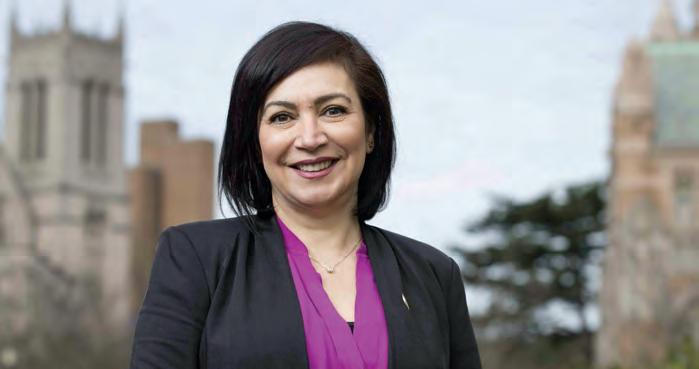
Since leaving Iran to study at the Karolinska Institute in Solna, one of the most prestigious institutions in Scandinavia (and the world), Emami has forged personal ties to the Queen Silvia Nursing Award—a formal designation backed by Her Majesty of Sweden for which the UW School of Nursing is the first US partner. Emami has worked to raise the visibility and status of nursing on a global scale.
CH: Carly Hinman
AE: Azita Emami
CH: What does the Queen Silvia Nursing Award represent to you? And to the UW School of Nursing?

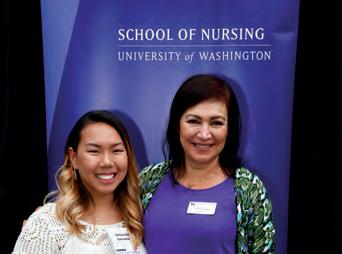
AE: The Queen Silvia Nursing Award represents the empathy and vision we too rarely encounter in today’s world. The Queen had a parent with dementia, as did I. She is using her visibility to inspire young nurses to have an interest in dementia care and to think in innovative ways about how that care can be made better for not only people with dementia, but also their caregivers.
CH: When did your family move from Iran to Sweden? What was it like living there after you emigrated?
AE: My husband and I fled the uncertainty and political instability that occurred after the coup that resulted in the 1979 exile of Shah Mohammad Reza Pahlavi—the last Iranian monarch.
It was, of course, a challenge to move to a country where culture, customs, and language were all very different from what I had grown up with. But this also contributed to my ultimate feeling that I am a citizen of the world.
CH: What drew you to the Karolinska Institute in Solna and a career in nursing?
AE: I always had an interest in pursuing a profession where I could help others. My interest in science, combined with my interest in helping others, made nursing a very positive choice.
Nursing offered many paths and many opportunities, from clinical practice to research. I was very fortunate to have been educated at one of the premier medical education institutions in the world, and I was fortunate to be educated in a country where there were no limits placed on the career a woman could pursue, or the ambitions she could have.
CH: The Karolinska Institute as a teaching establishment is very highly ranked. The 2020/2021 QS World University Rankings in particular place it very highly in the subject of Medicine: number one in Sweden, number three in Europe, and number six in the world. How does it compare to the University of Washington?
The Karolinska Institute and the University of Washington are among the world’s most distinguished educational institutions, alike in their dedication to quality and research, but different in their emphasis. Many people do not realize that Karolinska is a medical university, with a heavy emphasis on a wide range of biomedical research. A panel of fifty professors from different medical disciplines at Karolinska award the
short and long-term future of the field of nursing?

AE: There is unprecedented demand for nurses, and unprecedented opportunity for those who pursue a nursing career. The pandemic has made the world more aware of nurses, and more aware that nurses provide the majority of care that most people receive if they are hospitalized.
We have a situation right now where there is an enormous need for nurses, yet we are turning away tens of thousands of qualified applicants every year because we simply don’t have the facilities and faculty needed to admit them. The loss is ours.
CH: How do the research values at the UW School of Nursing align with those represented by the Queen Silvia Nursing Award?
annual Nobel Prize in Physiology or Medicine.
The University of Washington is a research-oriented general university whose schools and departments span the entire range of academic interests and professional preparation, from art to philosophy, and nursing to engineering.
The Karolinska University Hospital is a separate entity in close proximity to the Karolinska Institute, and it plays a key role in the clinical education of Karolinska’s nurses and doctors.
CH: Can you tell us more about your research and teaching, and how it has been informed by the places you have lived and worked?
AE: My research, teaching, and advocacy have been concentrated in two areas—research related to dementia, and efforts to raise the visibility and status of nursing on a global scale.
Dementia, unfortunately, is a reality in every country and culture. It is a relentless, progressive, and inevitably fatal disease that I experienced firsthand in my family, as well as seeing it every place I worked. Understanding how to provide better, more compassionate care for people with dementia became a quest that I continue today.
The ways in which nurses are educated, paid, and viewed professionally varies considerably between countries. I have traveled to Thailand, China, and many other places encouraging universities and governments to make nursing education a priority and to give nurses a prominent and equal place in healthcare planning as well as healthcare delivery.
CH: The global pandemic has been particularly challenging for those on the healthcare front lines; how has it affected your views towards the
Today, nurses are pursuing advanced degrees and certifications that enable them to provide safe, effective, and economical primary care. Around the world, nurses have more responsibility and more input on policy and budgeting than they have ever had. There is widespread recognition that if we are to reach international goals for healthcare equity, it will be nurses who get us there.
It is important to understand that this requires a substantial expansion of nursing education. It takes years to educate an advanced practice registered nurse. It requires facilities and faculty and a commitment to providing healthcare accessibility.
AE: The values align very well. Nursing research is practical, and solution-focused. Our four areas of research emphasis are health equity, symptom science, innovative interventions, and lifespan health. All of these areas are aspects of the work fostered by the Queen Silvia Nursing Award.
The Queen Silvia Nursing Award encourages nurses to innovate, create, and implement new ways of providing care. It puts our best and brightest minds to work seeking solutions that can immediately and directly benefit people with dementia and those who provide their care.
About the Queen Silvia Nursing Award: The Queen Silvia Nursing Award aims to encourage awareness of new and progressive ideas that can help tackle our society’s most pressing health issues, particularly within older persons and dementia care. Dedicated to driving cross-disciplinary engagement and awareness in the global challenges of aging demographics and the prevalence of dementia in societies, the Award is available in several countries through a close partnership with selected Main Country Partners and local Partners. Both nurses and nursing students are eligible.
Over the past two years, National Nordic Museum’s Executive Director Eric Nelson has served on the advisory committee for the University of Washington’s Queen Silvia Nursing Award.
Her
Highness,
IMAGES CLOCKWISE FROM UPPER LEFT: Royal Queen Silvia of Sweden. Dean Emami with University of Washington School of Nursing students (photos two and three). Robert G. and Jean A. Reid Executive Dean of Nursing Azita Emami, PhD, MSW, BSW, RN, FAAN at University of Washington.How do we use technology to track a pandemic, allow businesses to operate while people work remotely, solve supply chain issues, and create more sustainable cities?
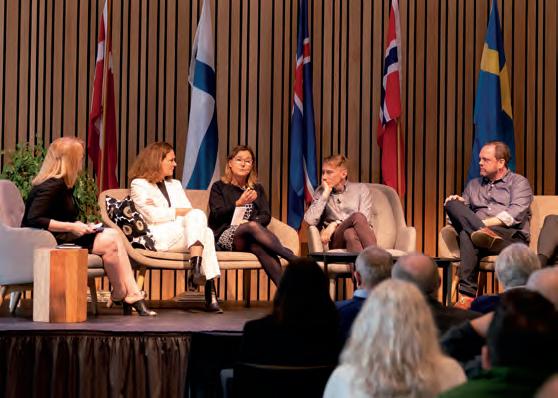
These are just a few of the questions raised in the Museum’s Nordic Innovation programs over the past two years.
“While the online events have been enormously popular over the last two years, we look forward to the return of an in-person Nordic Innovation Summit that would allow people to exchange ideas and make connections at the Museum,” said Leslie Anne Anderson, Director of Collections, Exhibitions, and Programs.
Nordic Innovation Summit 2022 opens May 19 with a keynote address from President of Iceland Guðni Jóhannesson titled “Innovation, Independence, and Interdependence.” The full-day summit is organized around the theme of “Innovating for Our Common Future,” and will include such panels as “The Future Workplace” and “Financing for Our Common Future.” Look for conversations about electric mobility, carbon sequestration, and sustainability and the circular economy too.
The Nordic Innovation Summit 2022 offers a new component this year, “Overnight Success Takes 11 Years.” This special evening for the venture capital and startup community, sponsored by Eyrir Venture Management, will include a presentation from Áslaug Arna Sigurbjörnsdóttir, Iceland’s Minister of Higher Education, Science, and Innovation, and luminaries from the Nordic and Pacific Northwest venture capital and startup ecosystem.
“There’s so much innovation and so much creation and new exciting things happening in the Nordic countries,” said Petra Hilleberg, Honorary Consul, Sweden, and CEO of Hilleberg the Tentmaker, who has played a significant role in the organization of each Nordic Innovation Summit since 2018.
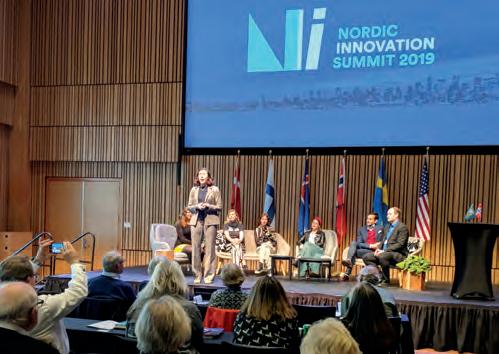
From launching the first all virtual Nordic Innovation Summit in 2020, which has attracted more than 6,000 viewers that year, to bringing Innovation programs back into the Museum in 2021 and 2022, including visits from Finnish dignitaries and Swedish royalty, the Nordic Innovation Series and upcoming Nordic Innovation Summit 2022 have emphasized the forward-thinking vision of the Museum. Here the Museum’s guests contemplate, discuss, and find solutions to such issues as how the future workplace operates, how companies find financing for new projects, and how the connections between the technology hubs of the Pacific Northwest and the Nordic countries can be fostered.
"When we opened the new Nordic Museum,” said Executive Director/CEO Eric Nelson, “the Nordic Innovation Summit was an instant hit. It has strengthened the Museum’s deep relationships to the tech and innovation sector here in Seattle and in the Nordic region. Through the Summit, people make connections with policy makers and thought leaders. Virtualizing the event during the pandemic expanded our reach and brought even more people to the Summit—this was an example of applying innovative thinking to our own programming. The growth and popularity of the summit is a reflection on the exceptional leadership of the Museum’s Nordic Innovation team chair Birger Steen. We’ve seen terrific growth in support from our public and private partners like Ericsson, Neste, Microsoft, Eyrir Venture Management, and the Nordic embassies and consulate generals in the US."
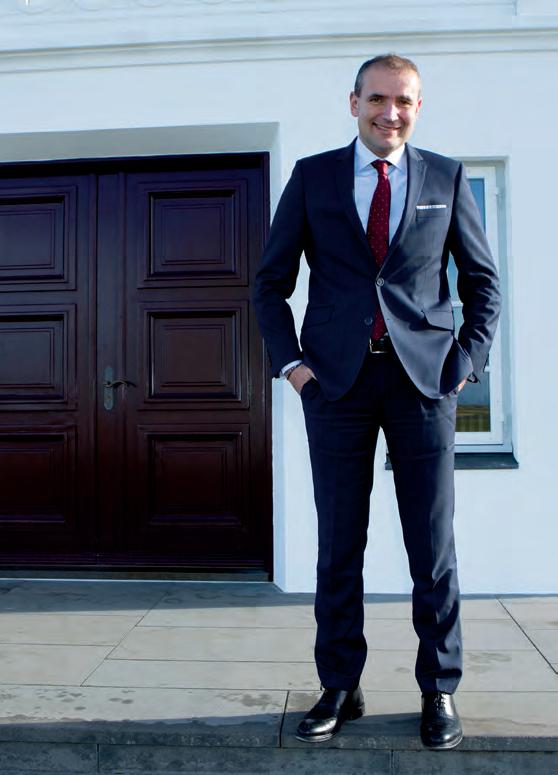

For over a decade, Icelandair has remained the fastest way to the Nordics, connecting the Pacific Northwest to the heart of Scandinavia through the Spirit of Iceland from Seattle, Portland and Vancouver.
Towering glaciers, rocky lava fields and mesmerizing auroras are included when you Stopover in Iceland for up to 7 days at no additional airfare.
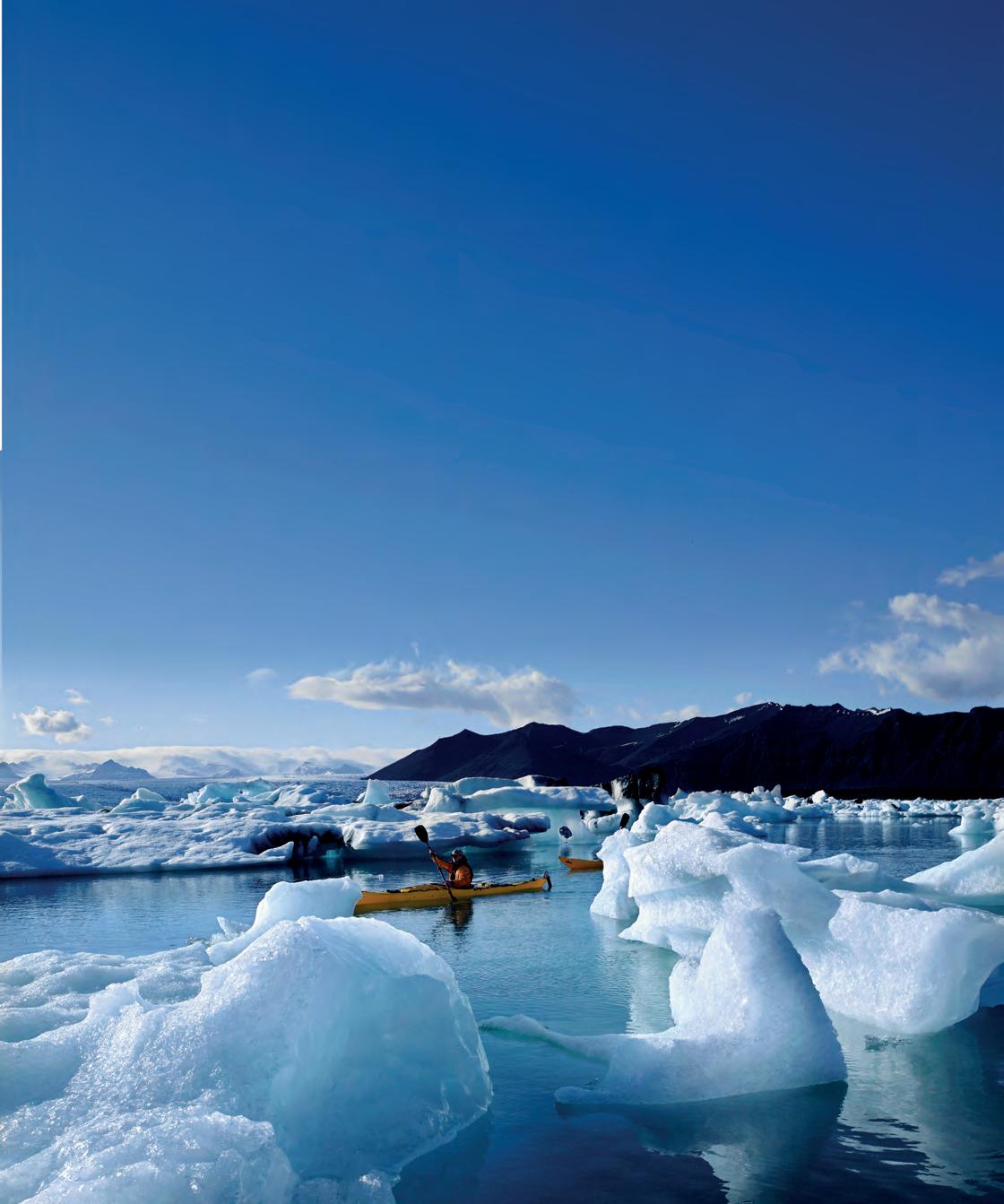
As Nordic Kultur went to press, preparations were in full swing for the visit of Sweden’s His Royal Highness Prince Daniel, Her Excellency Karin Olofsdotter, Ambassador of Sweden, and members of Prince Daniel’s Fellowship (Prins Daniels Fellowship & Entreprenörsprogram). The presentation of Knight First Class, Royal Order of the Polar Star will be made to Eric Nelson, Executive Director/CEO, during an evening dinner event on March 16.
His Majesty King Carl XVI Gustaf of Sweden awarded Nelson this honor in 2021 in recognition of his leadership in making the dream of a National Nordic Museum in Seattle, Washington, a reality.
Earlier in 2020, Nelson became the first Swedish-American to receive with the rarely awarded Hazelius Medal in Gold from the Nordiska Museet in Stockholm for the preservation and promotion of Swedish cultural heritage.
Like the Polar Star, the physical ceremony of the Hazelius Medal was delayed due to COVID 19. Nelson received his medallion, now on display in the Museum’s office, when visiting the Nordiska last fall. Along with the Museum’s Buildy Award and other honors, the Polar Star and the Hazelius reflect the increased recognition of the Museum’s work, said Nelson.
“These are significant honors to receive on the behalf of the Museum and the work our community has done to create this place,” said Nelson. “It is a testament to the international recognition of the Museum and its programs.”
In the letter informing Nelson and the Museum of the Polar Star, Karin Olofsdotter, Ambassador of Sweden to the United States, said, “You have in the most magnificent way succeeded in uniting the Nordic countries’

In 2020, the Museum debuted the Nordic Genealogy Conference, drawing on its strong history of providing support for amateur and professional genealogists. Due to the Museum’s closure at the time, the event was broadcast as virtual classes and lectures. The Virtual Nordic Genealogy Conference attracted more than 200 attendees from twenty-four states and three Canadian provinces.
Following the conference, several of the videos remained accessible to all on the Museum’s YouTube channel. Pacific Lutheran University Professor Troy Storfjell’s “Sámi Identity and Genealogy: What Does it Mean to be Sámi?” has been watched by more than 2,000 viewers since October 2020 and remains one of the most popular videos on the Museum’s channel.
The Nordic Genealogy Conference will return in the fall of 2022 with programming at the Museum and online. Professional genealogists and subject matter experts from North America and the Nordic countries will share insights about family history research for the Nordic region. The conference also will offer programming about blended heritage and transnational identities.
Eric Nelson, Executive Director/CEO, National Nordic Museum strengths and values at the National Nordic Museum through architecture, exhibitions, and programs. The National Nordic Museum is now a superior hub for public diplomacy in the USA and a central collaborative partner for the Embassy of Sweden as well as for all other Swedish-American organizations.”


Last year’s Nordic Talks: Food Security and Sustainability proved immensely popular with an international audience. Funded by the Nordic Council of Ministers and created in partnership with all five Nordic embassies, speakers from the Nordic countries and Washington State addressed feeding communities during COVID 19, food packaging and processing, the declining bee population’s impact on food production, and more ecologically-friendly management of food waste.
Now the recording of “Is there a Plan Bee?” has been added to the “Nordic Talks” podcast available on Spotify, Apple Podcasts, and the Nordic Talks website. This episode comes from an online Nordic Talks event organized by the Museum and features Melanie Kirby, Professional Apiculturist, Santa Fe, New Mexico, and Maria Kjetså, Advisor for Farm Animals, Nordgen, Ås, Norway. The conversation was moderated by Bob Redmond, Owner, Survivor Bee; Founder, The Common Acre; Seattle, Washington.

Morten Kjaerum, Director of the Raoul Wallenberg Institute of Human Rights and Humanitarian Law, will give this year’s Wallenberg Lecture on June 8 at the Museum. The hybrid event will mark a return to the traditional lecture at the Museum along with providing access to viewers around the world.

The founding director of the Danish Institute for Human Rights (DIHR) from 1991 to 2008, Kjaerum led the organization’s transformation to a large, internationally-recognized institution. He has been continuously involved since that time with human rights capacity building projects with governments and national institutions in all parts of the world.
Kjaerum served as one of the editors of COVID-19 and Human Rights, released in 2021. The work explored the wide-ranging consequences of the crisis, addressing interconnections between COVID 19 and human rights to equality and non-discrimination, including historical responses to pandemics, populism and authoritarianism, and the rights to health, information, water, and the environment.
In the spring of 2022, the Museum will launch its new website, providing a more seamless ticketing experience and greater access to virtual content. Over the past two years, the Museum’s online programming has grown exponentially, with lectures, book talks, international panels, and more.
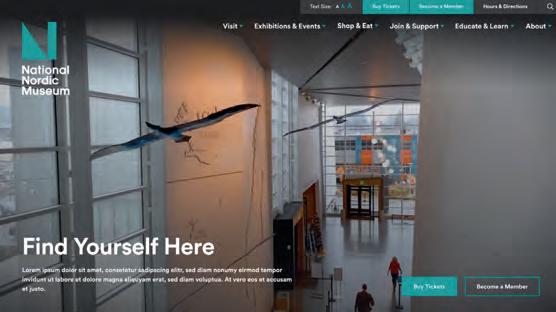
The new website makes revisiting these programs much easier and supports the Museum’s ongoing vision of serving as a national and international resource for people of all backgrounds interested in Nordic culture, values, and ideas.
Over the next year, look for more content and a new digital membership offering at nordicmuseum.org
Modern Design
Classic Ambiance
Historic Events
Meetings
Conferences
Retreats
Holiday Parties
Weddings
In May, 2022, the National Nordic Museum is pleased to welcome First Lady of Iceland Eliza Reid to Ballard to discuss her new book, Secrets of the Sprakkar: Iceland’s Extraordinary Women and How They Are Changing The World.


Born and raised in Ontario, Canada, Reid graduated from the University of Toronto with a bachelor’s degree in international relations. She went on to complete an Master of Arts degree in modern history from Oxford University. There, she met and later married historian Guðni Th. Jóhannesson, who became President of Iceland in 2016. After moving to Iceland in 2003, Reid worked as a freelance writer for many years, writing and editing for multiple Icelandic publications.
Reid is a patron of several organizations in Iceland, including the United Nations Association Iceland, as well as a Goodwill Ambassador for SOS Children’s Villages Iceland. She is also a staunch champion of women’s rights and equality, using her public position to advocate for gender parity in all aspects of government and society.
Offering a window into a country that sees the benefit of gender equality and how people everywhere can work towards achieving it, Secrets of the Sprakkar is the First Lady’s love letter to her adopted homeland of Iceland, which is often said to be the best place on Earth for women. Notably, the tiny island country has topped the World Economic Forum’s Gender Gap Index for the past twelve years.
nordicmuseum.org/rentals
Studies show increased equality leads to a happier, longer living, and more economically-prosperous society for all its citizens. From parenting to politics, sexuality to sports, Reid examines what has led to this level of equality in Iceland and shares insights on how we can all help to level the playing field in our day-to-day lives.
Through her own unconventional story and that of other sprakkar (Icelandic for “extraordinary and outstanding women”), Reid’s writing explores the unique combination of policy, people, and history that has resulted in Iceland’s unparalleled advances in gender equity.
The First Lady’s visit will take place on site at the National Nordic Museum, with a presentation given in Osberg Great Hall.

Iceland’s First Lady Eliza Reid to discuss her country’s leading example in the push for a more gender-equal world—and why it’s worth fighting forFirst Lady Eliza Reid in front of an Icelandic volcano. Secrets of the Sprakkar, by Eliza Reid. Pick up her book at the Museum Store.
In 2021, we reimagined Julefest, changing our largest community event of the year to an outdoor market. Moving the market outside made the event COVID-safe and was an instant hit. As it has for more than forty years, the Museum's Julefest kicked off the holiday season in style.




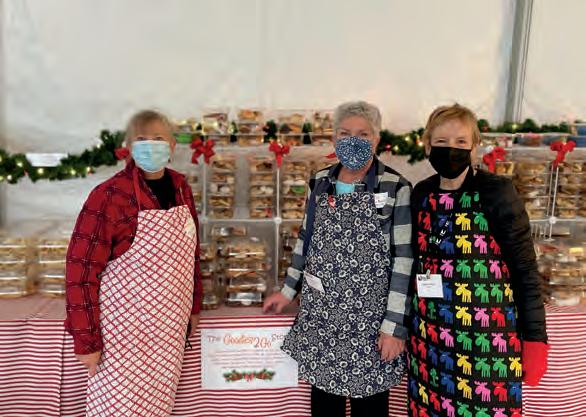
Moving the market to the Museum parking lot and The Fisherman’s Sun Terrace, vendors were quickly swamped with shoppers wanting to browse their goodies. Live music and other entertainment was featured in Osberg Great Hall, renamed the Valhalla Beer Hall for the event. Our popular Æbleskivers tent, Nordicthemed food trucks and beverages, and the Goodies2Go station drew lovers of Nordic cuisine. While some made it all the way home with their packs of cookies, others admitted that they couldn’t wait and nibbled on the spot.
After the festivities were over, we were able to reflect on this new vision of the Museum’s most popular event. With over 11,000 visitors, 6,000 Æbleskivers made by our tireless volunteers and staff, and many vendors being completely sold out, there’s no question that an outdoor reimagining was a success we intend to repeat.
We couldn’t have made this happen without all of the long hours our volunteers and staff put into this huge undertaking, as well as the support of the City of Seattle’s Department of Neighborhoods. Now that we have laid the groundwork, we look forward to many more Julefest Christmas Markets to come. Happy Jule!
Julefest was funded in part by a Neighborhood Matching Fund award from Seattle Department of Neighborhoods.
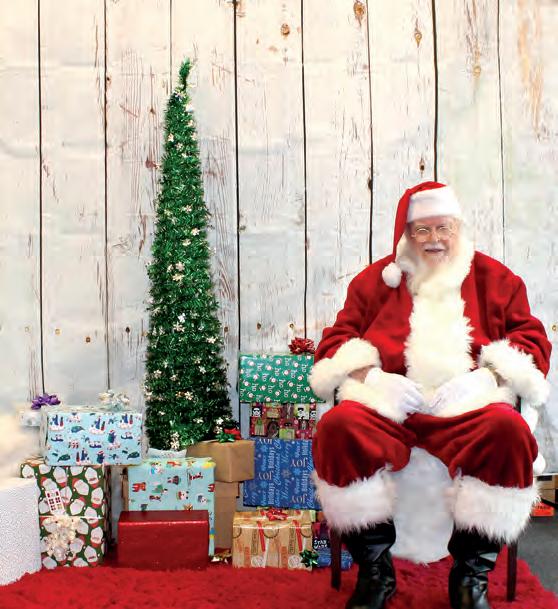


August 6–November 27, 2022
Norwegian and American Landscape Photography
